The post Buying AirPods as a gift? Make it extra special with this freebie from Apple first appeared on Joggingvideo.com.
]]>This story is part of Gift Guide, our year-round collection of the best gift ideas.
If you’re buying Apple’s new $179 AirPods 3 (the third-generation AirPods for 2021) directly from Apple’s website — or even the second generation AirPods, or the AirPods Pro — I can’t see many reasons you wouldn’t want to take Apple up on the offer to customize the wireless earbuds case for “free” (that is, it won’t cost more than the retail price).
You can express yourself with an array of emojis, making it easier to track down your case at a glance. The engraving can also help differentiate your case from someone else’s if you live with others, so you don’t accidentally put someone else’s gunky headphones in your ears. And not a whole lot beats adding some flair if you’re planning to give AirPods as a customized gift (just read these tips before you do).
Personalizing a new pair of AirPods easy to do during the ordering process, but there are a few things you’ll want to know.
How to customize your AirPods case when you order online
Apple introduced AirPods case engraving with the second generation AirPods. The process is pretty straightforward when you order a new pair of AirPods online.
Step 1: Go to the AirPods preorder page (in this case, for AirPods 3).
Step 2: Scroll down slightly and click the words Personalize them for free.
Step 3: A pop up window appears. Scroll through the options for emoji, numbers and two types of letter treatments that you can engrave on your case. You must select by tapping or clicking each character or symbol — you can’t simply type. You’ll be able to preview your emoji on this screen. Note that emoji don’t come in colors.
Step 4: Click Save when you’re done. You’ll see your emoji selections on the preorder page. Continue to purchase your AirPods.
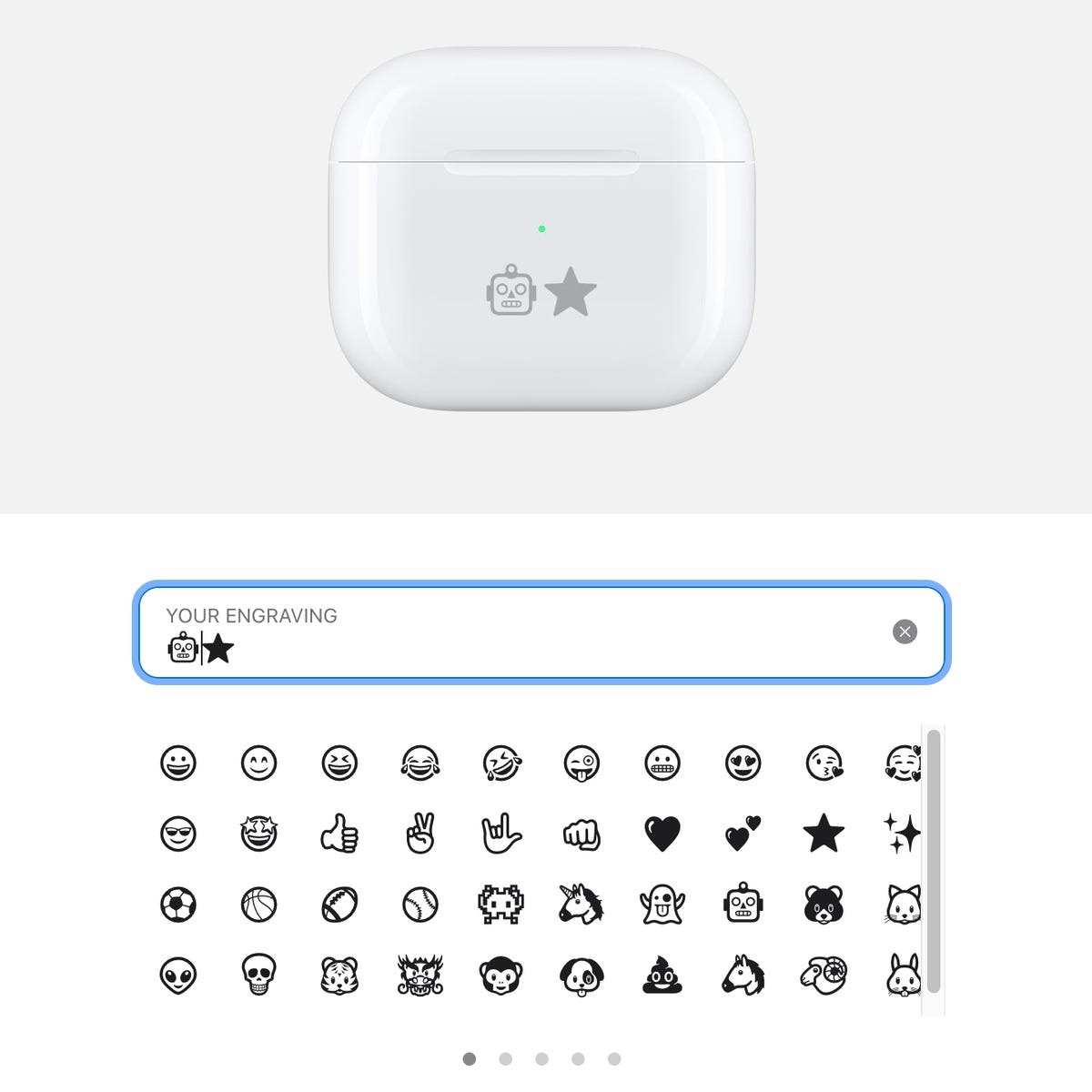

You, too, can make your AirPods case whimsical and completely yours.
Screenshot by Jessica Dolcourt/CNET
Will engraving delay my AirPods delivery?
In short, yes. In a test, we created orders with and without engravings. The AirPods 3 with the customized case had an estimated delivery time of almost three weeks. The non-customized pair, however, was available for same-day shipping (for a $9 shipping fee), or would ship in three days for free. Non-customized AirPods are also available to purchase in stores, or ordered online for in-store pickup. Customized AirPods need to be shipped. Depending on when you order and Apple’s fulfillment load, your delivery time may vary.
Can I choose any emoji I want for my AirPods case?
In our test on the AirPods 3 case, emoji were limited and it looked to our eyes like the lettering style has also changed since Apple first introduced the feature. Apple didn’t respond to a request for clarification.
See also
- Apple event recap: AirPods 3, new MacBook Pro and more
- Apple unveils new AirPods at $179
- Apple’s MacBook Pro display features a new notch, faster refresh rate
Can I pick up my engraved AirPods case at my nearest Apple store?
Apple’s preorder website indicates that store pickup for customized AirPods cases aren’t available at this time — Apple will ship your order.
Is there a catch if I buy the AirPods Pro with engraving?
Apple posts a retail price of $249 for the AirPods Pro. We’ve recently found them for as low as $190 or less (the price will drop even lower to $159 if you wait until Nov. 22). With Black Friday sales kicking in, prices on the AirPods Pro or even the brand-new AirPods 3 could drop again. If your heart isn’t set on engraving, you may save some cash by shopping around. Check out our best Black Friday AirPods deals roundup for the latest prices.
For all things AirPods, here are all the new AirPods 3 features, what to know about trading in your old AirPods and one of our favorite tricks for finding lost AirPods. Here’s everything Apple announced this week, including new MacBook Pros.
Find The Perfect Gift
AllUnder $10Under $20Under $50Under $100Under $250allmomsdadsgrandparentsfitnesstravelersteenspreteenstechgamingfoodiesromanticjewelryhomekids107 results
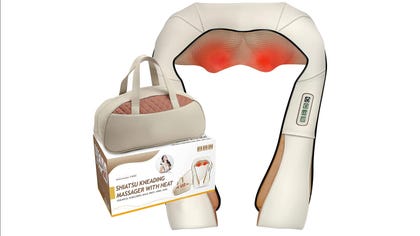
Five S Kneading Massager
$35 at Amazon

Hydro Flask
$35 at Hyrdo Flask

Nintendo eShop Gift Card
$50 at Amazon

Fox in the Forest
$12 at Amazon

SteelSeries Arctis 1
$50 at Amazon

Jacques Torres bonbons
$55 at Jacque Torres

A bouquet of exotic meats
$90 at Man Crates
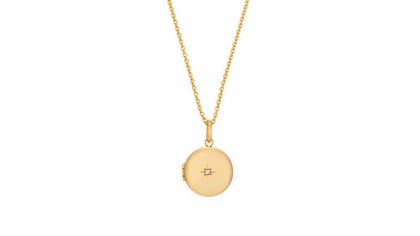
Sarah Chloe diamond locket
$145 at Sarah Chloe

The Bouqs Co. Pixie bouquet
$99 at The Bouqs Co.

Sweet heart bamboo
$35 at Plants.com

Max Brenner chocolates
$37 at Max Brenner

Ingarden microgreens garden
$100 at Amazon

Shun Sora Japanese petty knife
$70 at Amazon
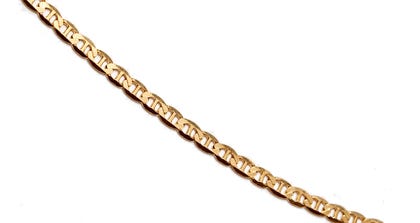
Wolf Circus Toni gold bracelet
$95 at Wolf Circus

Champagne Gummy Bears
$9 at Sugarfina

MakiMaki sushi roll kit for 2
$125 at MakiMaki

Cote des Roses rosé
$16 at Wine.com

Flavored Truffle Gift Box
$38 at La Maison du Chocolat

Barrel Aged Hot Hive Honey and Reaper Salt Series
$40 at Fuego Box

Carrie Hoffman X studs earrings
$290 at Carrie Hoffman

Wanna Date? sweet date spread
$12 at Uncommon Goods

Italian olivewood serving board
$17 at Sur la table
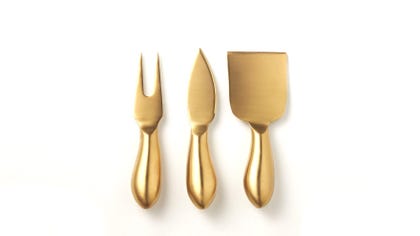
Three-piece cheese knife set
$20 at CB2
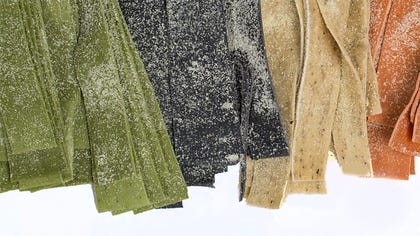
A delivery of fresh pasta
$25 at Goldbelly


Maison Miru heart nap earrings
$75 at Maison


Bokksu Japanese snack box
See at Amazon
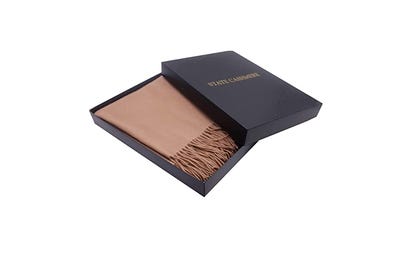

State cashmere blanket throw blanket
See at Amazon
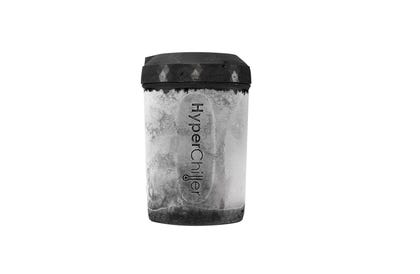

HyperChiller
See at Amazon


Nixplay smart digital photo frame
$20 at CB2


Online cooking classes
See at Online Cooking School
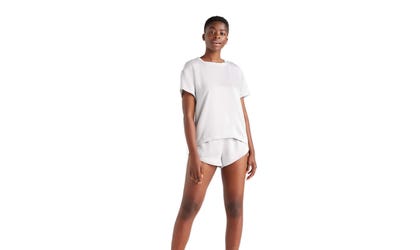

Washable Silk Tee & Shorts
See at Quince


Ouai Chill Pill Bath Bombs
See at Ulta


60 Hour Candle
See at TheraBox


Dyson Supersonic hair dryer
See at Dyson


Mint & Lily Mama necklace
See at Mint & Lily
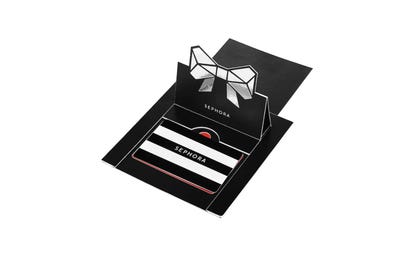

Sephora gift card
See at Sephora
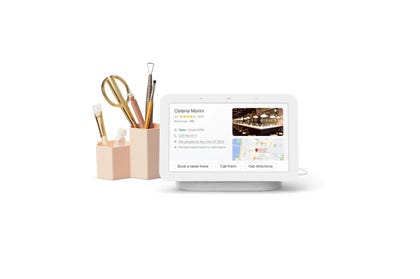

Google Nest Hub
See at Google


Theragun Prime
See at Therabody


Matador NanoDry Towel
See at REI


Mixbook
See at Mixbook
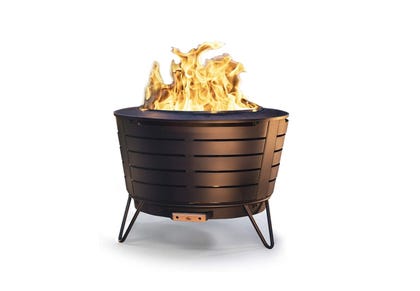

Tiki fire pit
See at Amazon
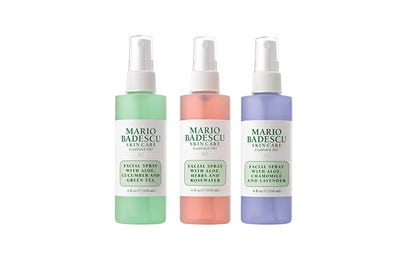

Mario Badescu face spray set
See at Ulta


Flower delivery from BloomsyBox
See at BloomsyBox
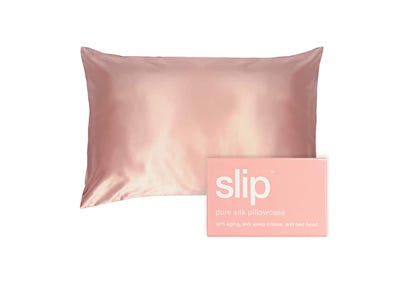

Slip silk pillowcase
See at Amazon


Aarke water carbonator
$230 at Bed Bath & Beyond


Disney Plus Gift Subscription
$80 at Disney


DJI Minin 2 Fly More Combo
$600 at Amazon


Fujifilm Instax Mini 11 Instant Camera
$69 at Amazon
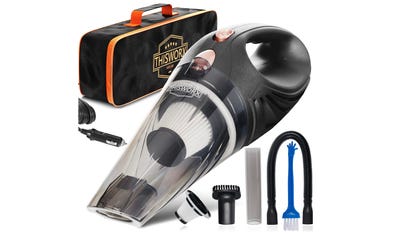

ThisWorx Portable Car Vacuum Cleaner
$36 at Amazon


Perfect Pot
$165 at Our Place


Letterfolk Customizable Tile Mat
$75 at West Elm


Parks Project Candle
$36 at Parks Project


iPad Mini 2021
$500 at Best Buy


Crown & Paw Pet Canvas
$50 at Crown & Paw


Coravin Wine Preservation System
$150 at Target


Botley 2.0
$47 at Amazon


Arcade1Up Arcade Machine
$600 at Best Buy


Biolite TraveLight 135
$40 at Biolite


Blockaroo Blocks
$40 at Amazon
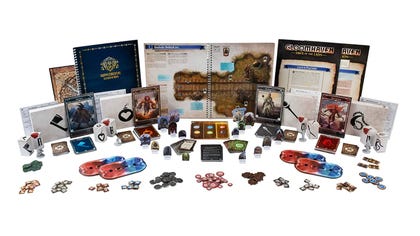

Gloomhaven: Jaws of The Lion Board Game
$32 at Amazon


JBL Go 3
$50 at Amazon


Illy Y3.3 Espresso and Coffee Machine
$149 at Amazon


Lenovo Smart Clock
$35 at Best Buy
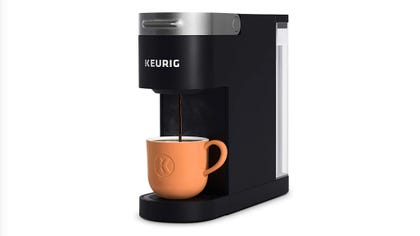

Keurig K-Slim Coffee Maker
$79 at Amazon


Lego Speed Champions Corvette
$30 at Amazon


Madewell Transport Tote
$178 at Madewell


Lunya Silk Sleep Mask
$48 at Lunya
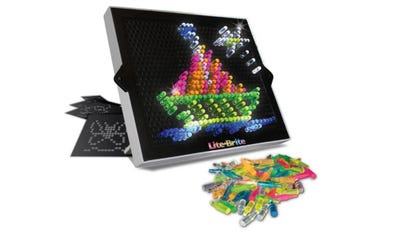

Lite-Brite
$13 at Target


Lodge Cast-Iron Grill Pan
$20 at Amazon


Wyze Cam v3
$36 at Amazon
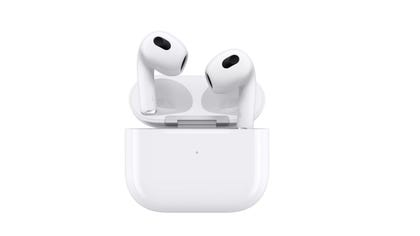

Apple AirPods 3
$150 at Amazon


EarFun Air Pro 2
$80 at Amazon


Sony WF-1000XM4
$250 at Walmart


Sony PlayStation 5
$499 at Amazon


Roku Express 4K Plus
$39 at Amazon


Apple iPad 2021 (9th generation)
$280 at Amazon


Acer Chromebook Spin 713
$530 at Amazon


MacBook Air M1
$1,000 at Best Buy


Bose SoundLink Flex
$150 at Best Buy


Dell G15
$1,100 at Best Buy
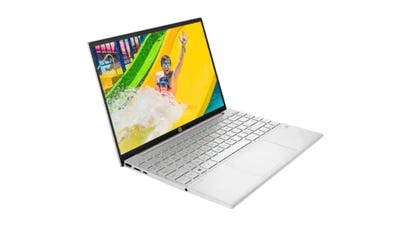

HP Pavilion Aero 13
$1,000 at HP


Lenovo Yoga 7i (2-in-1)
$850 at Best Buy


Mosaic Plant-Based Meal Delivery
$70 at Mosaic
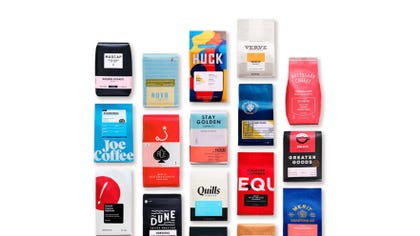

Trade Coffee Subscription
$40 at Trade


Vizio MQ7 65-inch
$1,000 at Amazon


Apple Watch SE
$269 at Amazon


Apple Watch Series 7
$399 at Best Buy


Atlas Tea Club
$199 at Atlas Tea Club


iPhone 11
$499 at Apple
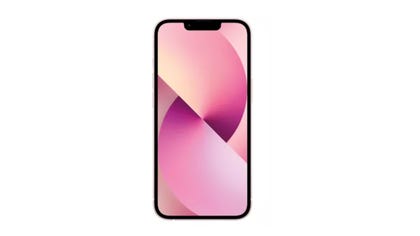

iPhone 13
$799 at Apple


Fitbit Charge 5
$179 at Amazon


Google Pixel 6
$599 at Amazon
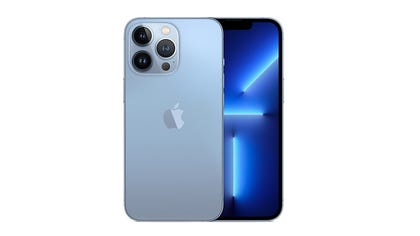

iPhone 13 Pro
$999 at Apple
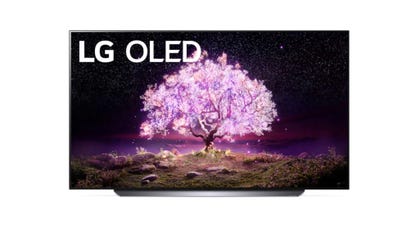

LG C1 OLED 65-inch
$1,797 at Amazon


Samsung Galaxy S21 Ultra
$1,166 at Amazon
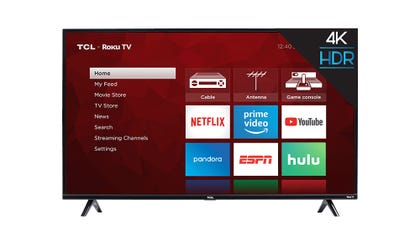

TCL Series 4 TV 65-inch
$529 at Amazon


TCL Series 6 TV 65-inch
$999 at Amazon


Theragun Mini
$199 at Amazon
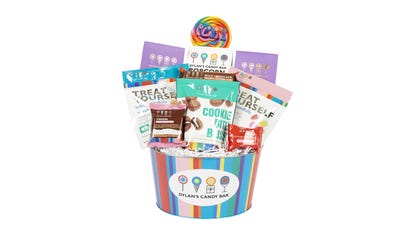

Best of Dylan’s Candy Bar Gift Basket
$100 at Dylan’s Candy Bar
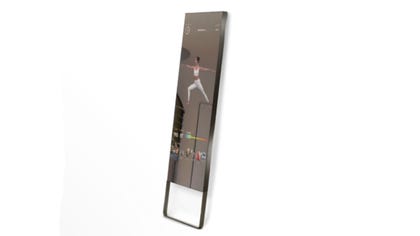

The Mirror
$1,495 at Mirror


Echo Dot with Clock
$60 at Amazon


Croissant Light
$19 at Amazon


Spanish-style Wine Glasses
$20 at Amazon


Nintendo Switch OLED
$350 at Target


Xbox Series X
$499 at Amazon
The post Buying AirPods as a gift? Make it extra special with this freebie from Apple first appeared on Joggingvideo.com.
]]>The post Have you seen the cartoon app everyone’s using on Facebook lately? What we know about it first appeared on Joggingvideo.com.
]]>
I’ve tried my fair share of cartoon avatars, from the very first Yahoo Messenger avatar I ever used, to Bitmoji stickers. There’s something I find deeply and irresistibly compelling about seeing myself represented in cartoon form, as if the cartoon has the power to capture my core essence while outstretching a more playful version of myself. When I first saw Voila AI Artist’s version pop up in my Facebook feed, suffusing friends of all ages with an inner glow and supersize eyes quivering with emotion, my eyes went as wide as the cherubic rendering before me. I had to try it out for myself.
Creations from Voila AI Artist — an app that seemingly popped up out of nowhere — have mushroomed across my Facebook feed and proliferate on Instagram and WhatsApp as well. (Both are owned by Facebook.) The app starts with a photo of your face and renders it into three different cartoon styles to choose from, complete with shading. “Disney” is the adjective that’s popped up most often when friends and coworkers see my avatar. In addition to the cartoon rendering, you’re also able to see yourself from the eyes of Renaissance painters and create a caricature of your mug (or someone else’s).
Voila AI Artist is free for iPhone and Android, with a premium ad-free option as well (more on that, and on the app’s privacy policy, below). At any rate, it took less than five minutes to download the app and make my first cartoon grid. I also learned a few things along the way. Here’s how to do it and what to know.


My cousin’s Voila AI Artist photos, which sparked it all. Shared with permission.
Screenshot by Jessica Dolcourt/CNET
How to make yourself a cartoon avatar with Voila AI Artist
Step 1: Download Voila AI Artist for iPhone or Android and launch the app. It will ask for permission to use your phone’s camera roll.
Step 2: Select from among the four styles: 3D Cartoon (what I used here), Renaissance, 2D Cartoon and Caricature. Tap the arrow to begin.
Step 3: Your camera roll is now open. Select the photo you want to use, or tap Camera or Celebrities at the bottom of the screen to take a new picture or to search for celebrities. This generates a grid of four options. On the free version, expect to see an ad or two interrupt your view. After a few beats, you can X out the ad and return to your images.
Step 4: You’ll see four options — the composite grid of your original photo plus your three cartoon renderings and all three renderings (Royalty 3D, Baby 3D and Cartoon 3D). You can either take a screenshot from here and crop it down, or select any of the four options and click the edit button — an up arrow on Android — to immediately share on Facebook, Instagram or WhatsApp, or to email, save or share through other options (when you press More).
To remove the watermark, speed up the rendering process and remove the ads you see each time you render, you could update to the Voila Pro version for $2 per week, $4 per month or $21 a year — the price at the time of writing. There’s a free, three-day trial with that option.
What doesn’t work well with Voila AI Artist
- Nonhumans, such as dogs or cats
- Images where the app says faces can’t be detected
- Images of cut-off heads often work, but with an odd halo the app fills in
Voila AI Artist security and privacy: Is the app safe?
From what we can tell, although the app’s parent company says it will delete your photos 24 to 48 hours after the photo was last used by the app, it does collect personally identifying information about you, your phone and your activity online.
It then shares that personal data with third-party partners and advertisers in countries outside your own, including advertisers that may track your activity across the web. The app also discloses your personal information to any of its sibling companies, affiliates or subcontractors.
According to the privacy policy from app owner WeImagine.AI:
“When you use the free version of the App, we work with advertising partners to display advertisements within the App. These advertisements are delivered by our advertising partners and may be targeted based on your use of the App or your activity elsewhere online.”
CNET has reached out to WeImagine.Ai for comment and clarification.
CNET’s Rae Hodge contributed to this story.
The post Have you seen the cartoon app everyone’s using on Facebook lately? What we know about it first appeared on Joggingvideo.com.
]]>The post Best unlocked Android smartphones you can get today first appeared on Joggingvideo.com.
]]>Something strange is happening in the US, where wireless carriers once sold dramatically different phones, and buying an unlocked handset through a store that wasn’t your carrier was a risky proposition best left for the gadget-savvy. Now, two-year contracts are practically a thing of the past, most-wanted phones appear on all major networks, and phone-makers are beginning to succeed in selling handsets directly to buyers.
Unlocked phones are on the rise.
Simply buy a SIM card, stick it in your device, and you’re good to go. There’s no need to wait for activation, and best yet, you can keep your phone around for as long or as short a time as you’d like without paying any surprise fees. Here are some of our favorite handsets that you can purchase and use wherever you go — even all around the globe — carrier-free.
(You can use them on any compatible network; in the US, that’s mostly AT&T and T-Mobile, though Motorola phones will also work with Verizon and Sprint’s network technologies.)
Editors’ note: This piece was originally published June 12, 2012 and updates regularly.

The Motorola Moto G is a great-value budget phone. In fact, it’s one of the best, contract or no.
Sarah Tew/CNET
Motorola Moto G (late 2015 edition)
Motorola continues to crank out Goldilocks phones whose look and feel manage to lure us in, even when the specs are ho-hum. For $220, you get a comfortable, 5-inch display with a decent camera and 16GB of storage, plus, you can swap backplates to add your own flair. There’s an even cheaper model with half the storage and RAM for $180, but in our opinion, this is the one worth getting. (We’re also looking forward to the higher-caliber Moto X Pure, but that isn’t out yet at the time of this story.) Read CNET’s full Motorola Moto G review here.
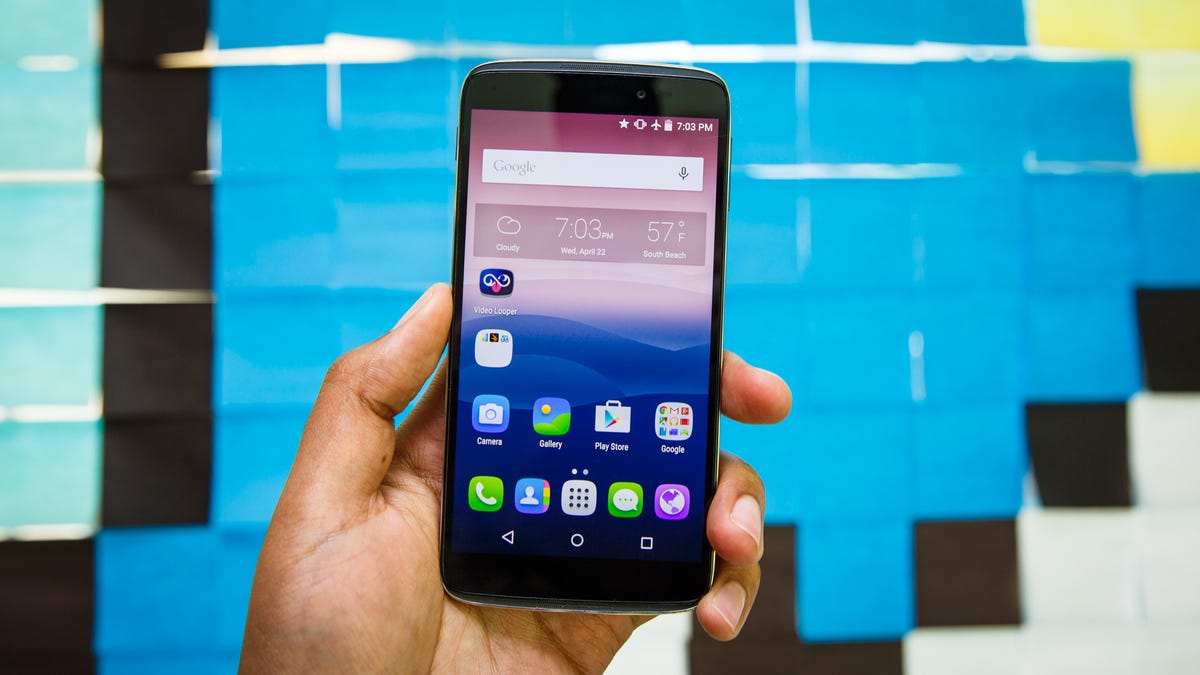

On the Idol 3, either way is “up”.
Josh MIller/CNET
Alcatel OneTouch Idol 3
For $250, Alcatel’s Idol 3 is a high-value Android handset with a nice 13-megapixel camera, good speakers, and a large, high-resolution screen. Alcatel’s phone also has an unusual feature: its software flips “up” no matter how you hold it. Read the full Alcatel OneTouch Idol 3 review.
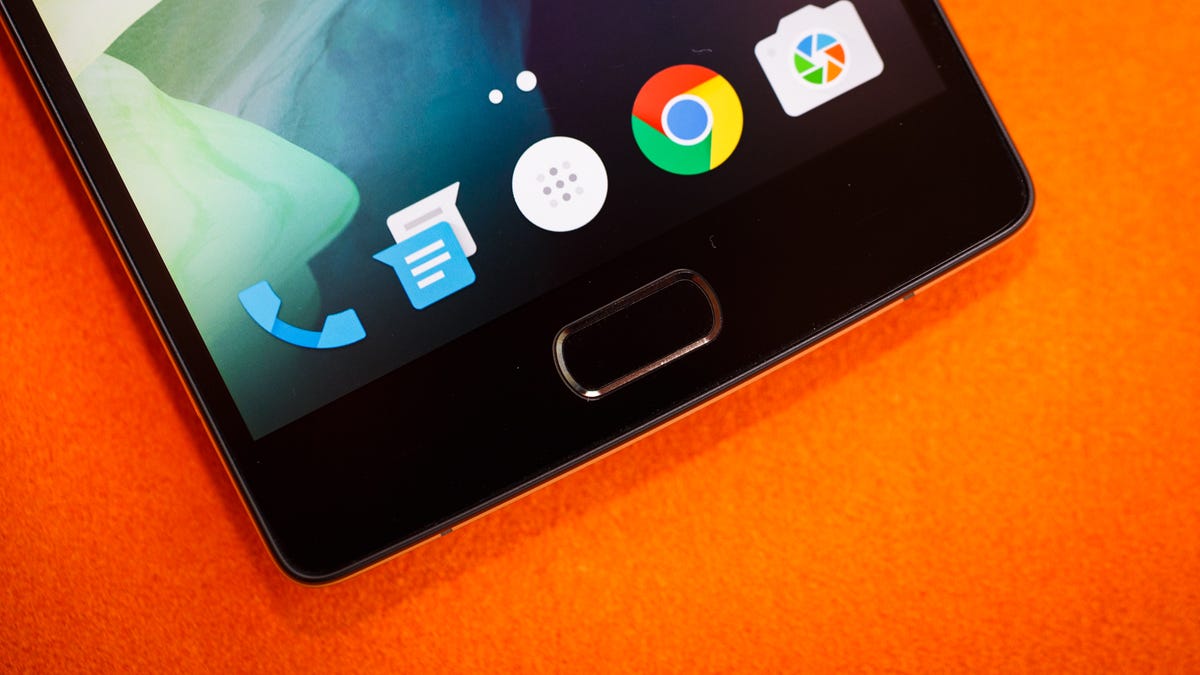

You can buy four backings if “sandstone” doesn’t do it for you.
Josh Miller/CNET
OnePlus 2
The sequel to last year’s OnePlus One improves the phone’s design, hardware and software. It gains a metal (rather than plastic) rim, a sliding switch to manage notifications, and specs that include a 5.5-inch display and a respectable 13-megapixel camera that takes nice shots. It costs $390 for the 64Gb version and there are four alternate backings you can buy, such as in Kevlar or wood, if the default “sandstone” isn’t your thing. Read the full OnePlus 2 review.
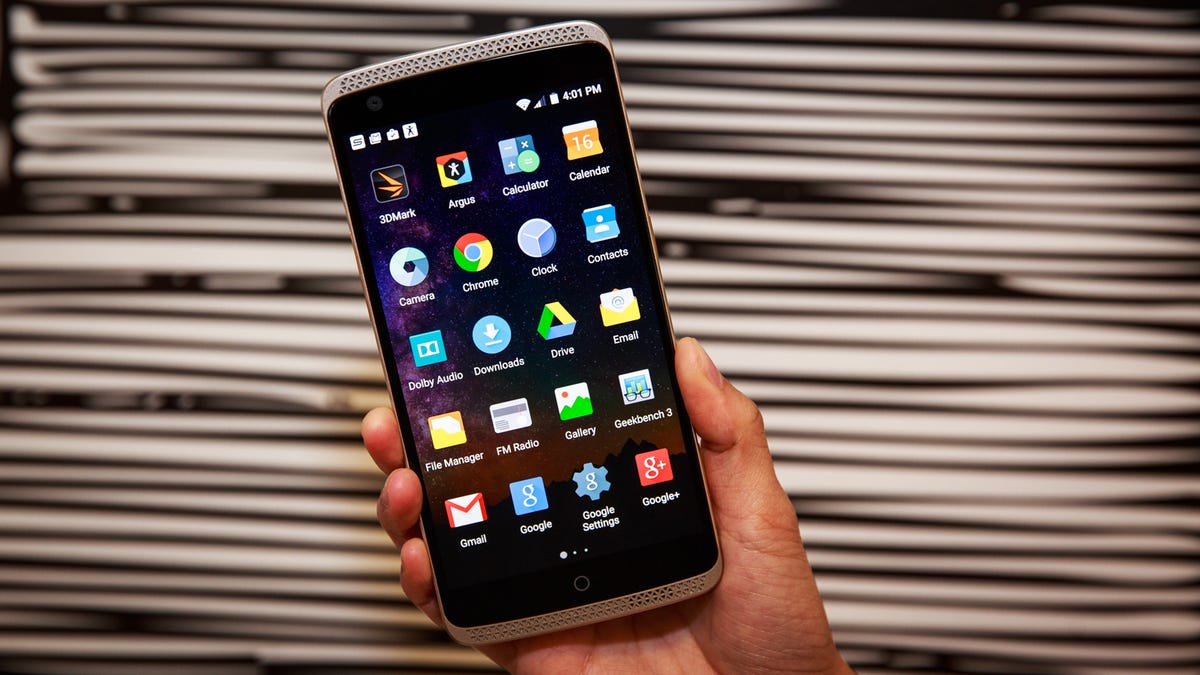

This is our favorite ZTE phone yet.
Josh Miller/CNET
ZTE Axon Pro
ZTE’s high-end Axon Pro is a competitively-priced flagship worthy of the name. Its $500 price tag brings with it an ultracrisp 2,560 x 1,440-pixel resolution on a 5.5-inch screen, and its polished body comes in three colors: blue, silver and gold. The phone’s capable 13-megapixel camera and hardware performance make it a truly excellent unlocked handset. Read the full ZTE Axon Pro review.


This is a likable $250 device.
CNET
Huawei P8 Lite
It’s got a pretty, lightweight design with a 5-inch screen and all the Android software fixings. This $250 phone gives others in the budget category a run for their money. While specs aren’t as high as on Alcatel’s phone, for instance, the P8 Lite still satisfies casual users. Read the full Huawei P8 Lite review.
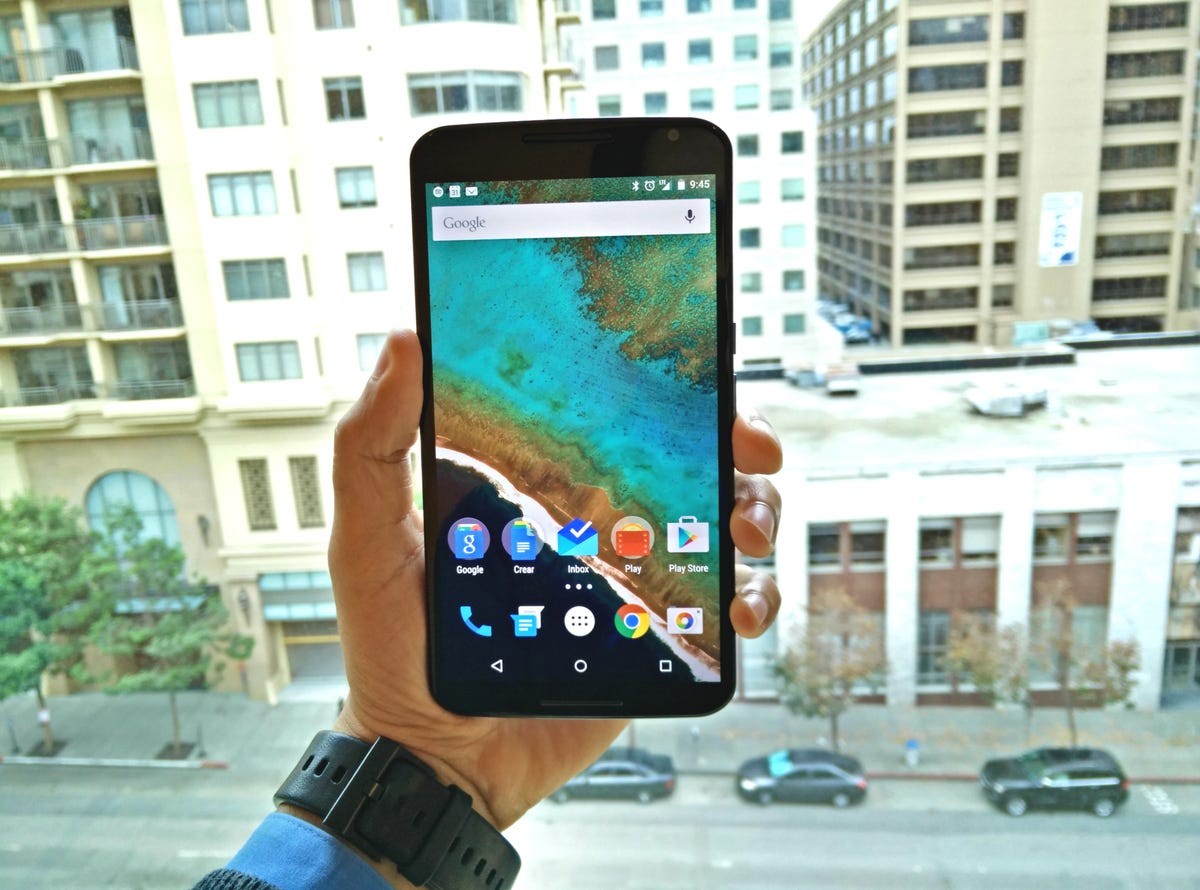

The Nexus 6 has a whopping 6-inch screen.
Juan Garzón / CNET
Google Nexus 6
Even while we wait for Google’s next Nexus phone (or phones) to come bursting out of the gate, the Nexus 6 will still hold its value (though we recommend waiting for the Nexus 7 to push prices down on the 6.) The company’s “pure” Android phones boast high-end specs without any custom software, and moderate pricing. As a result, the phone — which you can buy from Google’s online store — is among the first to update to each ensuing version of its Android software. In this case, prepare yourself for Android 6.0 Marshmallow. Read the full Google Nexus 6 review.
Read more: Best iPhone 2021: Apple currently sells 7 different models. Here’s how to pick one
The post Best unlocked Android smartphones you can get today first appeared on Joggingvideo.com.
]]>The post Galaxy Note 20: Here’s who should buy it and who should upgrade to the Ultra first appeared on Joggingvideo.com.
]]>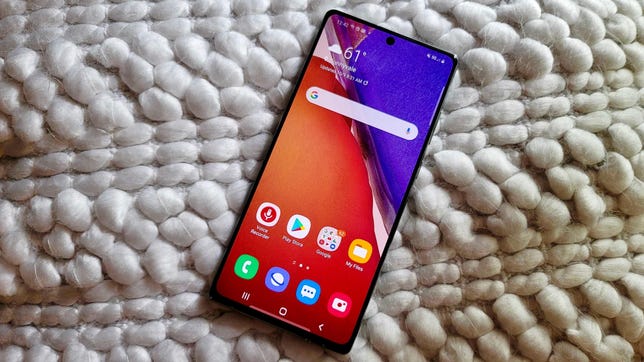
8.2
Samsung Galaxy Note 20 5G
$966 at Amazon
$950 at Best Buy
Get Price Alerts
$550 at Samsung
You’re receiving price alerts for Samsung Galaxy Note 20 5G
Like
- Brilliant screen
- Solid camera with 3x optical zoom
- Powerful, high-end performance features
- All-day battery life
Don’t Like
- Lacks premium look and feel
- Plastic backing can feel sharp and poorly constructed
- Too expensive at full retail price
Samsung has a knack for turning out powerful phones, especially in its Galaxy Note line. This year, it has two, the standard Galaxy Note 20 5G, which launched at $1,000 (£849, AU$1,499, both 4G) and the Note 20 Ultra, which launched at $1,300 (£1,179, AU$1,849, again both 4G). Both have sharp displays, excellent cameras, all-day battery life and impressive internal performance, along with an S Pen stylus that makes the Note unique. But you can only buy one, so which will it be?
This Galaxy Note 20 review focuses on the differences between 2020’s Note phones in the hopes it’ll help answer your questions while you make a decision — or just drool over Samsung’s large-screen devices. On the whole, I can recommend both Notes, just not at their retail prices.
I suggest keeping an eye out for deals, bundled offers, discounts and trade-in values that bring the prices down by $300 or more. Both phones will have fluctuating prices throughout the holiday season — check out CNET’s guide to the best Black Friday phone deals. Samsung prices tend to fall as the months go on, so your chance of snagging a deal are high. Plus, a surprise recommendation at the end if you’re not sold on using the S Pen stylus daily.


Now playing:
Watch this:
Galaxy Note 20 vs. Ultra: Which should you buy?
9:19
Design differences matter: Screen, plastic vs. glass
The Galaxy Note 20 and Note 20 Ultra clearly look like different devices, but not just because of the Note 20’s slightly smaller 6.7-inch screen to the Note 20 Ultra’s 6.9-inch display.
It’s apparent that the Ultra has a glass backing (Gorilla Glass Victus, in fact,) while the Note 20 uses polycarbonate (that’s plastic). If you use a case, it might not make a difference to you, but after all these years of being conditioned to equate a premium, $1,000 device with glass construction, plastic makes it feel cheaper than its price tag, even though the specs are strong.
I also noticed a sharp edge where the Note 20’s plastic backing joins the metal frame, meeting in a gap big enough to run my fingernail all the way around. If you’re going to use a case, it might not bother you, but Samsung can and should do better.
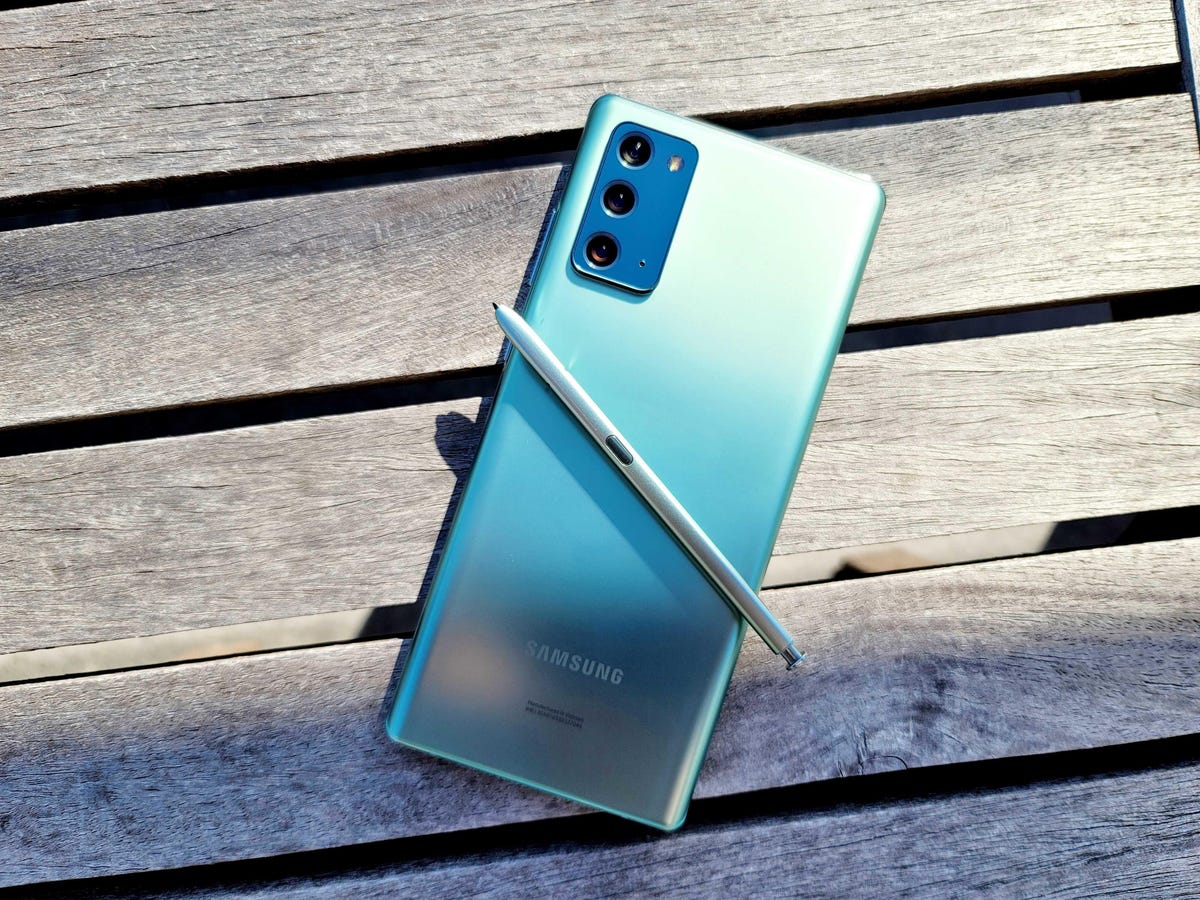
Samsung’s Galaxy Note 20 in mystic green.
Jessica Dolcourt/CNET
There’s no curved screen on the Note 20 the way there is on the Ultra. That doesn’t bother me, but the edge-to-edge display on both phones means there are still plenty of accidental screen presses when you’re simply holding the phone. For example, if you’re passively watching a video and shift your finger to find a more comfortable grip, you may wind up inadvertently triggering a button.
The final design difference worth noting is the 120Hz screen refresh rate on Ultra, compared to the standard 60Hz rate on the Note 20. It won’t make a difference if you’re switching from a 60Hz phone, but it can feel comparatively “slow” if you’re switching from a phone with a 90Hz or 120Hz display.
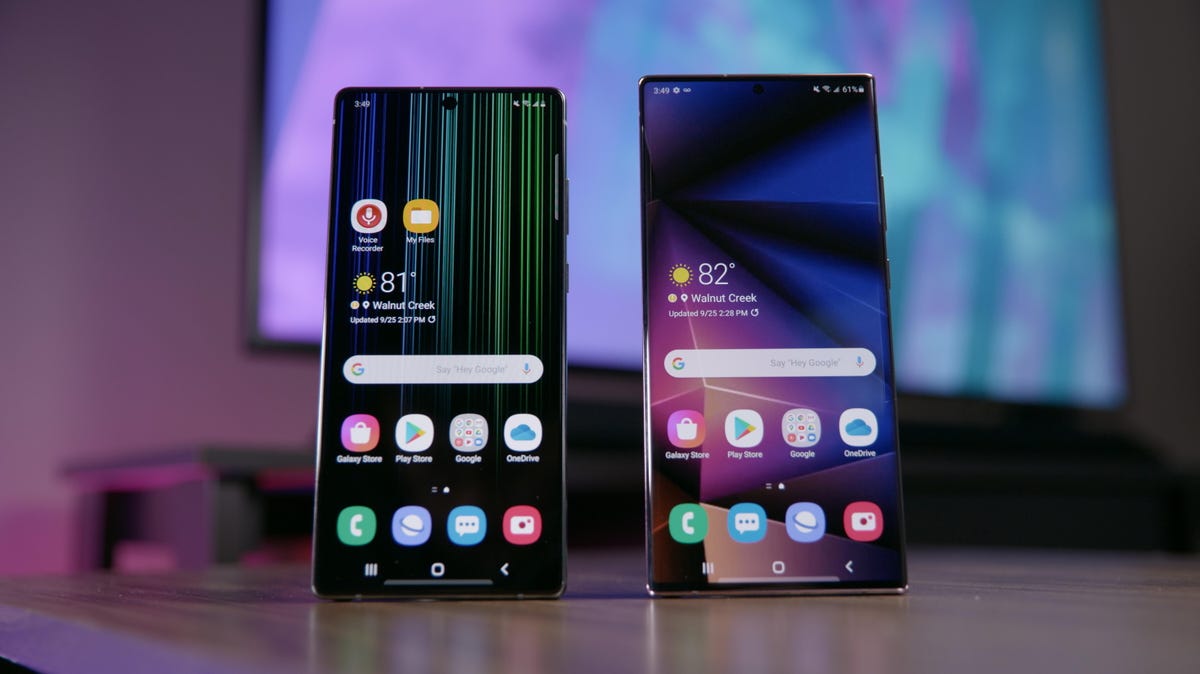

The Galaxy Note 20, left, has a plastic back, compared to the Note 20 Ultra, right, which has a glass back.
John Kim/CNET
The Note 20 Ultra is the clear camera winner
The Ultra’s has a massive and protruding camera array on its back to accommodate larger sensors and perhaps help it stand out. Meanwhile, the Note 20’s camera bump makes the phone less top-heavy and prone to rocking when you write on it while it’s on a flat surface.
But the Note 20 Ultra took better photos overall. You’re going to get great great shots no matter which phone you use, when you’re taking photos in brightly lit conditions: saturated color, crisp edges, the works. But if you’re at all interested in zoom photography, the Ultra’s 5x optical zoom takes the crown. Not only does it get you very good telephoto images up to 5x, it can also go up to 50x.


This cute harbor seal was photographed at 30x on the standard Note 20.
Jessica Dolcourt/CNET


Same seal, shot on Galaxy Note 20 Ultra at 50x zoom.
Jessica Dolcourt/CNET
The Note 20’s 3x optical to 30x AI-assisted zoom is still good as well, and better than the Galaxy Z Fold 2 (which has 2x optical zoom), but image quality at 30x was better on the Ultra than on the regular Note 20. Most of the time the Note 20 will fulfill your photographic needs. But when I took them both to the moody Northern California coast, many of my nature shots were simply better on the Ultra and I stopped reaching for the note 20 altogether.
The Ultra has a 108-megapixel camera you can use to crop into shots for more detail, a feature I’ve found to have uneven results.
Camera: Note 20 vs. Note 20 Ultra
| Galaxy Note 20 | Galaxy Note 20 Ultra | |
| Main camera | 12-megapixel (f1.8, Dual Pixel AF, OIS, 1.8μm, 79-degree FOV, 1/1.76-inch image sensor) | 108-megapixel (f1.8, OIS, 0.8μm, 79-degree FOV, 1/1.33-inch image sensor) |
| Ultra-wide angle | 12-megapixel (f2.2, 1.4μm, 120-degree FOV) | 12-megapixel (f2.2, 1.4μm, 120-degree FOV) |
| Telephoto | 64-megapixel (f2.0, 0.8μm, 76-degree FOV) | 12-megapixel (f3.0, 1.0μm, 20-degree FOV) |
| Front-facing camera | 10-megapixel (f2.2, 1.22μm, 80-degree FOV) | 10-megapixel (f2.2, 1.22μm, 80-degree FOV) |
| Zoom | 3x hybrid | 5x optical |
| Super Zoom | 30x | 50x |
| Laser auto-focus sensor | No | Yes |
| Video capture | 8K | 8K |
Features the Note 20 and Ultra share
- 5G data speeds (some regions have 4G models)
- Signature Note S Pen stylus
- Android 10 out of the box
- Snapdragon 865+ processor (other markets use a Samsung Exynos chip)
- Extras like fast wireless charging
Other notable differences
- Screen size, battery (4,300 vs. 4,500)
- MicroSD card
- 512GB option with Ultra
- 8GB RAM versus 12GB RAM on Ultra
Samsung’s Note 20 Ultra 5G is striking from every angle
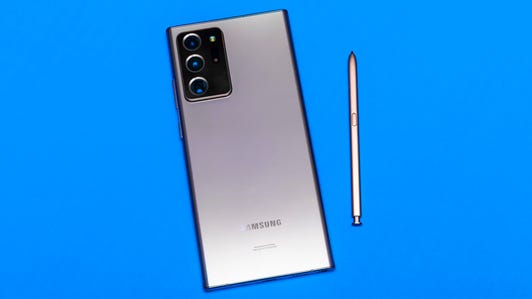





+24 more
Should you buy the Note 20, Note 20 Ultra, or a different phone?
The Note 20 Ultra is too big, too heavy and too expensive. But I’d still personally buy it over the Note 20 because I do find myself using the extra camera features. However, I don’t actually think it’s worth $300 more than the Note 20 just to have a 120Hz screen, 5x optical zoom instead of 3x, a glass backing and a microSD card storage option — plus all the other extras.
Most people will be happier with the cheaper Note 20 over the Ultra, but again, I think Samsung has overcharged for both phones at their full retail price, and I find the Note 20’s $1,000 price tag for what is essentially a plastic phone cheeky at best and insulting at worst.
For either phone, look for a deal. I’d be happier to pay $1,000 for the Ultra and $700 for the standard Note 20, if we’re keeping Samsung’s $300 price delta intact.
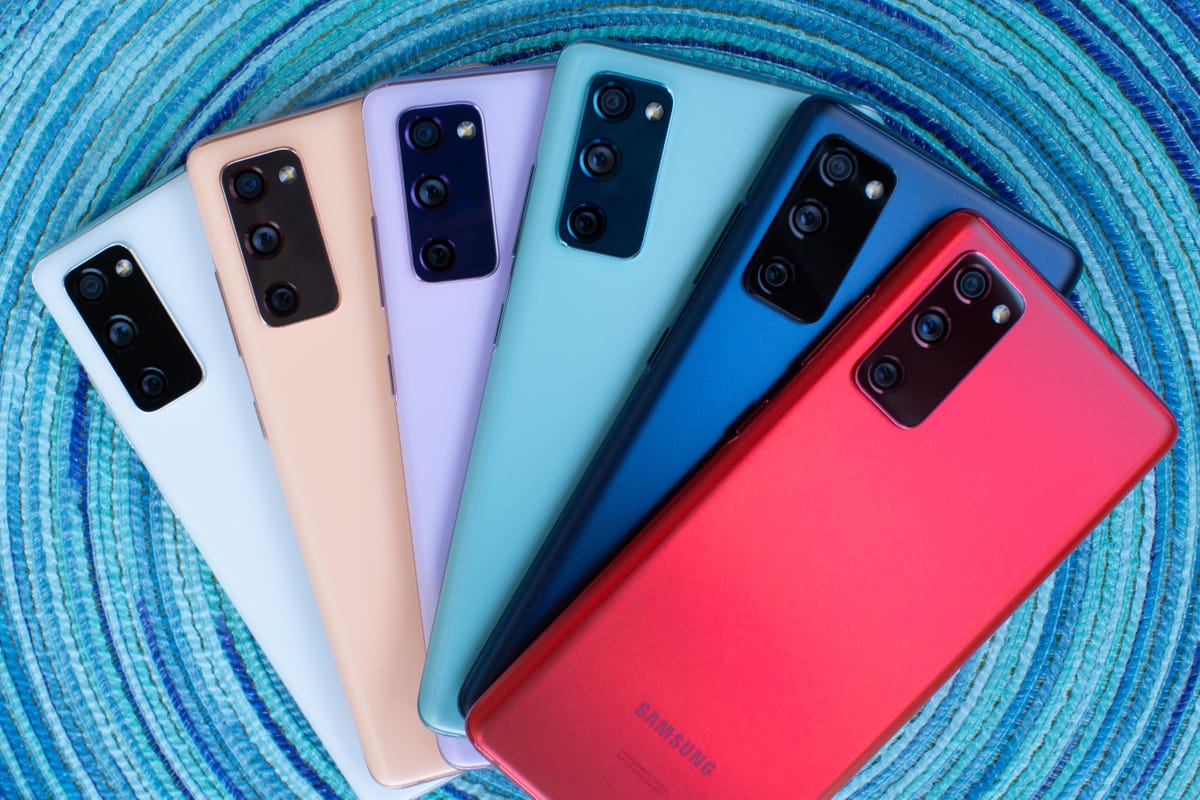

The Galaxy S20 FE comes in a range of colors.
Angela Lang/CNET
Here’s another alternative within the Samsung cosmos. The newer Galaxy S20 FE (Fan Edition) is a middle way. It merges some of the Ultra’s best features with the Note 20’s cost-cutting trade-offs, bringing you a 6.5-inch display with a fast 120Hz refresh rate, a big 4,500-mAh battery, 3x optical zoom and a rear plastic backing. There’s expandable storage, too, and of course, support for 5G data speeds.
While the cameras won’t be quite as good, and there’s no S Pen stylus, the Galaxy S20 FE is the best buy in terms of value, if not a status symbol — though it does come in fun colors.
Best yet, it starts at $700 full retail and was already on sale for $600 in some stores by the time it hit the market. With trade-in values and seasonal deals, I expect that price to fall.
Galaxy Note 20 vs Note 20 Ultra vs S20 FE
| Samsung Galaxy Note 20 | Samsung Galaxy Note 20 Ultra | Samsung Galaxy S20 FE | |
| Display size, resolution | 6.7-inch; 2,400×1,080 pixels | 6.9-inch; 3,088×1,440 pixels | 6.5-inch super AMOLED; 2,400×1,080 pixels |
| Pixel density | 393ppi | 496ppi | 405ppi |
| Dimensions (Inches) | 6.36 x 2.96 x 0.33 in | 6.49 x 3.04 x 0.31 in | 6.29 x 2.97 x 0.33 inches |
| Dimensions (Millimeters) | 161.6 x 75.2 x 8.3 mm | 164.8 x 77.2 x 8.1mm | 159.8 x 75.5 x 8.4mm |
| Weight (Ounces, Grams) | 6.84 oz, 194g | 7.33 oz, 208g | 190g |
| Mobile software | Android 10 | Android 10 | Android 10 |
| Camera | 12-megapixel (ultra-wide), 12-megapixel (wide-angle), 64-megapixel (telephoto) | 12-megapixel (ultra-wide), 108-megapixel (wide-angle), 12-megapixel (telephoto) | 12-megapixel (standard), 12-megapixel (ultra-wide), 8-megapixel (3x telephoto) |
| Front-facing camera | 10-megapixel | 10-megapixel | 32-megapixel |
| Video capture | 8K | 8K | 4K |
| Processor | Snapdragon 865+ | Snapdragon 865+ | Qualcomm Snapdragon 865 (5G) Samsung Exynos 990 (4G) |
| Storage | 128GB | 128GB, 512GB | 128GB |
| RAM | 8GB | 12GB | 6GB |
| Expandable storage | No | Up to 1TB | 1TB |
| Battery | 4,300mAh | 4,500mAh | 4,500mAh |
| Fingerprint sensor | In-screen | In-screen | In-screen |
| Connector | USB-C | USB-C | USB-C |
| Headphone jack | No | No | No |
| Special features | S Pen stylus; 5G connectivity; Wireless PowerShare; water resistant (IP68) | 120Hz screen refresh rate, 5x optical zoom, UWB sharing, S Pen stylus; 5G connectivity; Wireless PowerShare; water resistant (IP68) | 120Hz screen refresh rate, support for 30W fast charging and 15W fast wireless charging |
| Price off-contract (USD) | $1,000 | $1,300 (128GB), $1,450 (512GB) | $699 |
| Price (GBP) | £849 (4G), £949 (5G) | £1,179 | £599 (4G), £699 (5G) |
| Price (AUD) | AU$1,499 (4G), AU$1,649 (5G) | AU$1,849 (4G), $AU$1,999 (5G) | AU$999 (4G), AU$1,149 (5G) |
First published Oct. 10
The post Galaxy Note 20: Here’s who should buy it and who should upgrade to the Ultra first appeared on Joggingvideo.com.
]]>The post Galaxy Note 20 Ultra review: Amazing features, but is anyone a ‘power user’ anymore? first appeared on Joggingvideo.com.
]]>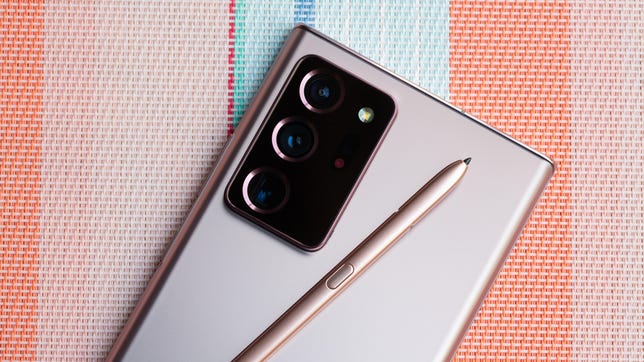
8.4
Samsung Galaxy Note 20 Ultra 5G
$605 at eBay
Get Price Alerts
You’re receiving price alerts for Samsung Galaxy Note 20 Ultra 5G
Like
- Sleek lines, matte bronze finish
- Exceptional screen quality and 120Hz refresh rate
- 5x optical zoom captures sharp photos in ample light
- S Pen creates standout opportunities for using the phone
Don’t Like
- $1,300 is too expensive right now
- A large, heavy, awkward phone
- Unsightly camera bump that invites breakage
- Note 20 Ultra rocks when you lay it down flat
If you’re looking for Samsung’s new Galaxy Note 20 Ultra to be a do-everything phone, you won’t be disappointed. Like other Note phones that came before it, the Note 20 Ultra is aimed at a rarified group of Android “power users” who want a phone with all the toys and aren’t afraid of a higher price tag. With the Ultra, there’s plenty of both.
Samsung saved its best features for the Galaxy Note 20 Ultra, including a more refined design than the Galaxy S20 Ultra — a phone I don’t recommend. You’ll find an exceptional 6.9-inch screen, sharp 5x optical zoom camera and a swifter stylus for annotating screenshots and taking notes. The Note 20 Ultra also makes small but significant enhancements over the Note 10 Plus, especially in the camera realm.
Do these features justify the Note 20 Ultra’s price? It begins at $1,300 (£1,179, AU$1,894) for the 128GB version (you can also buy it in 512GB). The retail price is a steep ask, especially when you combine a climate of deep global recession and mounting unemployment. Add that to the fact that if your active work and social lifestyle has changed at all, like mine has, you won’t truly take advantage of all the features this phone has to offer. Will the Note 20 Ultra still be the phone you want to use post-pandemic, or will a better upgrade come along by then?
Read more: iPhone 12 Pro’s camera vs. Note 20 Ultra: Portraits, selfies, night mode and more
Order from Amazon | Samsung | Verizon | AT&T | Xfinity Mobile | T-Mobile | US Cellular | Best Buy


Now playing:
Watch this:
Galaxy Note 20 Ultra is a do-everything device that’ll…
12:47
I’ve always enjoyed using a Galaxy Note, for the stylus as well as the sleekness of the line’s design. The Ultra produces top-notch specs, checks all the boxes, and I want to love it. But for me, it doesn’t totally come together, and in terms of value, it’s a miss. Unless you already know you can’t live without it, it’s hard to recommend the Ultra for all but the most loyal Note fans, or people upgrading from older phones.
If you get a good enough trade-in deal or bundled offer, I think you’ll be more than happy with the features and performance, even if some aspects, like the protruding camera bump, aren’t your favorite. But if you want to reserve a little money this year and save your splurge when you have more certainty and freedom of movement, there are plenty of excellent devices well below $1,300 that will see you through until then, including the Google Pixel 4A, Samsung Galaxy A51, iPhone 11 or 11 Pro and OnePlus 8 or 8 Pro.
Read on to learn everything from screen quality to sample photos from the Note 20 Ultra’s cameras. Scroll to the end for the full list of specs compared to the standard Galaxy Note 20. Samsung also unveiled one more super-ultrapremium phone this year, the Galaxy Z Fold 2.
Samsung’s Note 20 Ultra 5G is striking from every angle






+24 more
Is the Note 20 Ultra’s mystic bronze color really all that? Can you still see fingerprints?
I’m in love with the mystic bronze color of my Note 20 Ultra review unit. It’s got a subtle shimmer that to me feels understated and elegant, without losing a dynamic finish. In certain lighting, it looks rose gold. The matte finish does a lot to keep fingerprints on the back to a minimum — I can barely see them.
Switching to the S Pen will immediately keep the screen cleaner than typing with your fingers, but I use both input methods on the phone. Mystic white and mystic black, which I have not seen in person, have glossy glass backings.
How good is the screen?
The 6.9-inch display is excellent: clear and sharp, with an approach to the 120Hz screen refresh rate that’s much more polished and useful than Samsung’s first attempt with the Galaxy S20 Plus and S20 Ultra. The default mode is “Adaptive” motion smoothness, which turns on 120Hz refresh when you’re scrolling or using features that can take advantage of the faster screen. It’ll flip to the 60Hz standard when the screen is static, saving on battery overall. You can also toggle to 60Hz if you’d like to preserve even more.
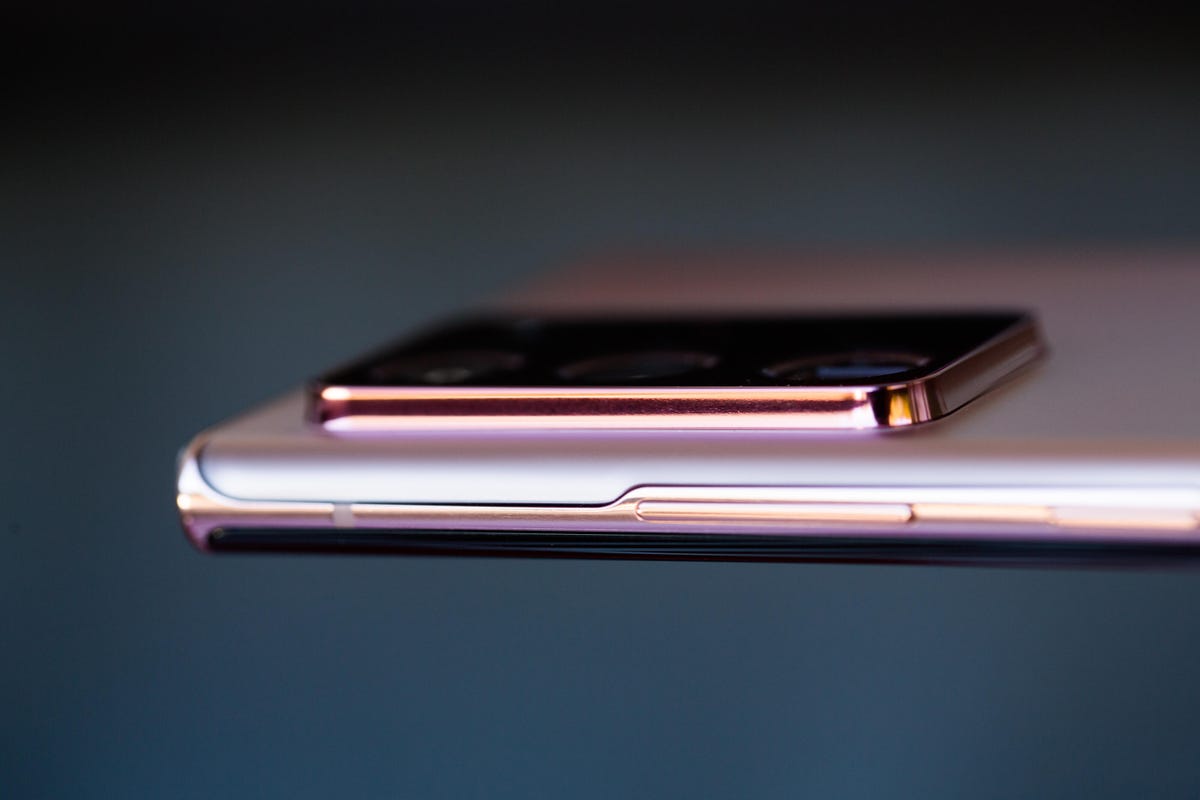
You trade off large camera sensors for a big ol’ bump that keeps the phone from lying flat when you put it down.
Angela Lang/CNET
Is the Note 20 Ultra’s curve still relevant in 2020?
I love the classy, immersive look of a curved, waterfall edge. But the Note 20 Ultra’s true edge-to-edge display made it hard to place the cursor at the edges of the screen where I wanted it to go, and I noticed — especially when lying down — that gripping the phone while typing or navigating often called up other apps or features unintentionally, or else closed out what I wanted to do. A little more grip buffer — or better touch rejection along those edges — would go a long way.
What kind of glass protects the camera and phone?
Samsung uses the new Gorilla Glass Victus on the Note 20 Ultra’s front and back. Corning claims the cover material can withstand drops up to 2 meters (about 6.5 feet) and is also twice as scratch-resistant compared to Gorilla Glass 6, which is rated for a 1.6-meter (5.25-foot) fall.
But the camera module, which sticks out from the back, is covered with Gorilla Glass 6, meaning that if the phone were to fall on its back and hit this part first, it would be theoretically more prone to breaking than the rest of the device. I’ve had cracked glass over my camera lens before and it ruined every portrait shot I tried taking after. A case might really help fill in the empty space and distribute forces in the event of a fall. Check out the results of our Galaxy Note 20 Ultra drop test — spoiler alert, we were able to break this phone.


Now playing:
Watch this:
Comparing the Galaxy Note 20 Ultra and iPhone 11 Pro…
7:34
What about the Ultra’s big camera bump?
When I first got the review unit from Samsung, I described the design as siren-meets-cyclops. It’s actually nicely styled, but it’s still just too big. The main problem is that when you place the Note 20 Ultra on a flat surface, like your table, and start writing or navigating with the S Pen, the phone actually rocks. This has happened on all of CNET’s review units.
Is the fingerprint reader better than on other Galaxy phones?
Yes. Fingerprint scanning errors still happen, but few and far between, and I usually get in on the second try. This makes mobile payments a lot easier. My pro tip since the S10 is this: Enroll your dominant thumb twice, your other thumb once and your dominant index finger once. You have a total of four fingerprint profiles to work with.
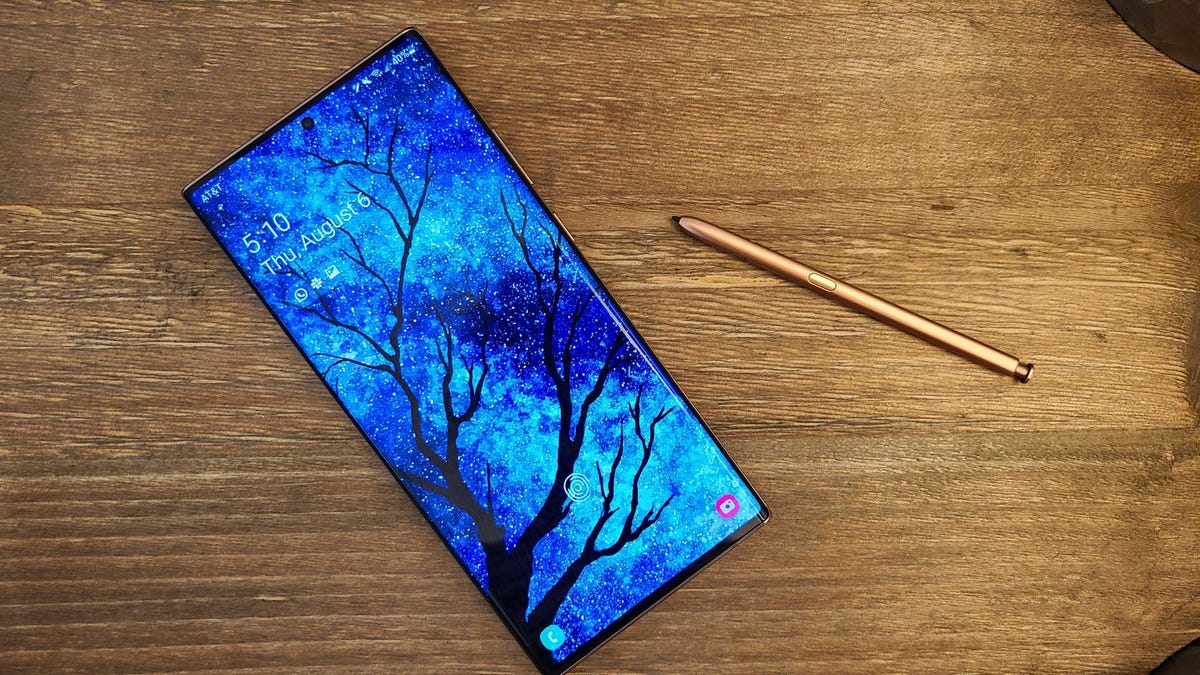

The Note 20 Ultra has a crisp, vibrant screen.
Jessica Dolcourt/CNET
How is the Note 20 Ultra’s zoom quality?
The phone’s 5x optical zoom is really sharp and produces excellent shots when there’s ample lighting. I liked how a tip popped up on screen as I took a photo of a buttery, multilayered croissant, suggesting I shoot at 2x and pull back. Much better photo.
Samsung pulled back from 100x Space Zoom on the S20 Ultra and I’m glad. The 50x zoom on the Note 20 Ultra is enough for most uses, and much improved with the higher optical zoom output to start with. Use it to capture scenes you might ordinarily be too far away to get, like a cute dog with its head out the window, a hawk circling overhead or shooting a funny street sign.


I took this picture using auto mode on the Galaxy Note 20 Ultra.
Jessica Dolcourt/CNET
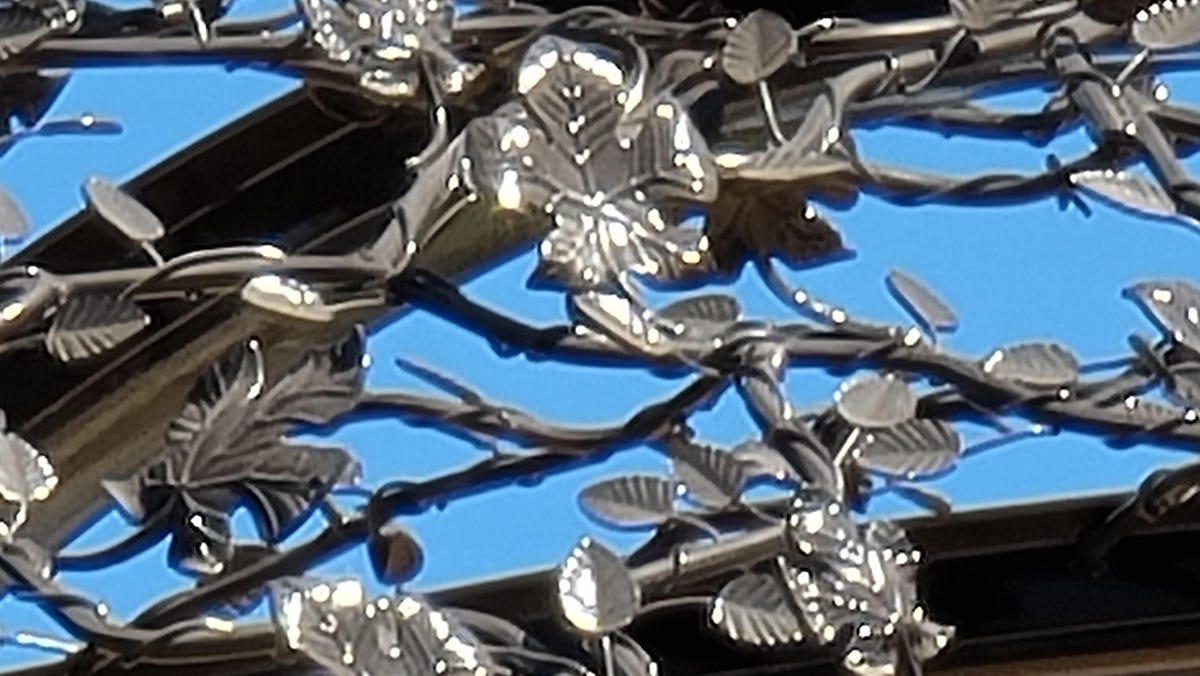

Here we are at 50x zoom, the highest the Note 20 Ultra will go.
Jessica Dolcourt/CNET
What about the rest of the cameras?
Taking photos with the Note 20 Ultra phone was a lot of fun. I was a little limited by the present circumstances with the range of photos I naturally wanted to take, but I still found shots I loved: purple clouds rippling in an impossibly pink summer sky, a delicious picnic lunch and a glowing candle at an outdoor restaurant at night.


Shot in auto mode on the Galaxy Note 20 Ultra — no filter.
Jessica Dolcourt/CNET
The Note 20 Ultra has a 108-megapixel camera feature, which lets you take a detailed shot and crop photos after the fact. My results were uneven, with a blown out photo of a flower that completely lacked detail, to a fairly successful shot of a bug that had landed on my shirt. Night mode and selfie quality were solid, and I especially like the new selfie filter that lets you warm up or cool down the tone before you take a shot.
On the left: close up on auto mode. On the right, the phone prompted me to choose 2x zoom and lean back a bit. Good suggestion #Note20Ultra pic.twitter.com/xWEooqV3RF
— Jessica Dolcourt (@jdolcourt) August 8, 2020
Pro video mode is a Note 20 Ultra exclusive, and is packed with settings that are frankly over my head because I’m not a professional videographer. I did like being able to change the microphone direction, and smoothly zooming in was a nice feature, but quality during night shoots was poor. Here’s how the Galaxy Note 20 Ultra’s camera compared to the iPhone 12 Pro’s.
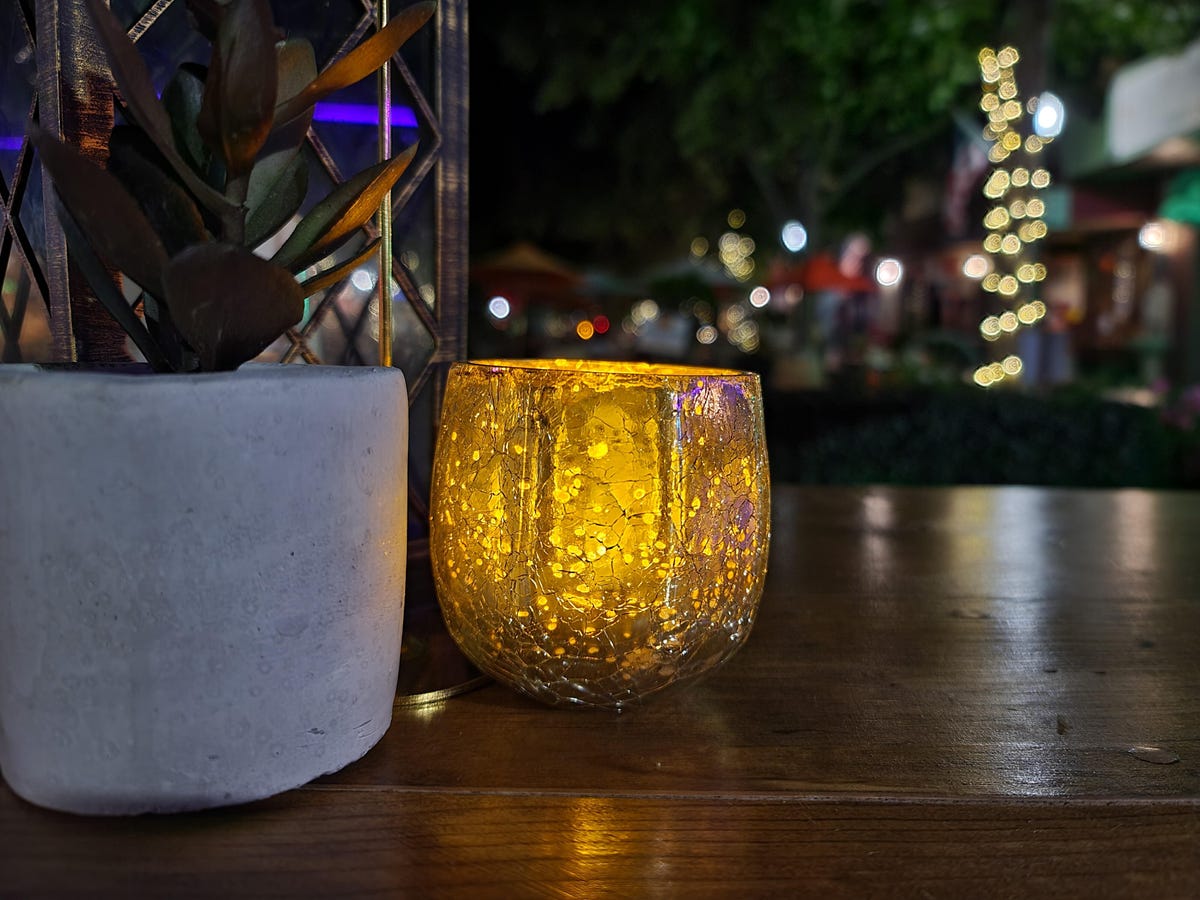

A nighttime photo taken without night mode from the Note 20 Ultra.
Jessica Dolcourt/CNET
Note 20 vs. Note 20 Ultra camera
| Galaxy Note 20 | Galaxy Note 20 Ultra | |
|---|---|---|
| Main camera | 12-megapixel (F1.8, Dual Pixel AF, OIS, 1.8μm, 79-degree FOV, 1/1.76 inch image sensor) | 108-megapixel (F1.8, OIS, 0.8μm, 79-degree FOV, 1/1.33 inch image sensor) |
| Ultrawide angle | 12-megapixel (F2.2, 1.4μm, 120-degree FOV) | 12-megapixel (F2.2, 1.4μm, 120-degree FOV) |
| Telephoto | 64-megapixel (F2.0, 0.8μm, 76-degree FOV) | 12-megapixel (F3.0, 1.0μm, 20-degree FOV) |
| Front-facing camera | 10-megapixel (F2.2, 1.22μm, 80-degree FOV) | 10-megapixel (F2.2, 1.22μm, 80-degree FOV) |
| Zoom | 3x hybrid | 5x optical |
| Super Zoom | 30x | 50x |
| Laser auto-focus sensor | No | Yes |
| Video capture | 8K | 8K |
How’s battery life?
The Note 20 Ultra’s 4,500-mAh battery is smaller than the S20 Ultra’s 5,000-mAh battery, but lasted much longer during my testing period. I’m not hotspotting for hours during a commute these days or going out from early morning until late night, which makes it harder to compare anecdotally. However, I’d call battery life good, not amazing, and it’ll certainly take you through a typical day.
On my heaviest use days, I navigated with Google Maps for about an hour and a half and spoke on the phone for over an hour with no significant drain. I routinely take two hours of meetings calls while on a walk, without issue. I’ll update this review once I have results from our more formal lab tests in New York.
Are there any standout S Pen features in the Note 20 Ultra?
Because of the 120Ghz refresh rate, the S Pen writes noticeably faster. There’s also lower latency overall (under 9 milliseconds, according to Samsung). I also feel my writing is neater. Samsung introduces new features, like handwriting auto-straighten and PDF importing, which I like.
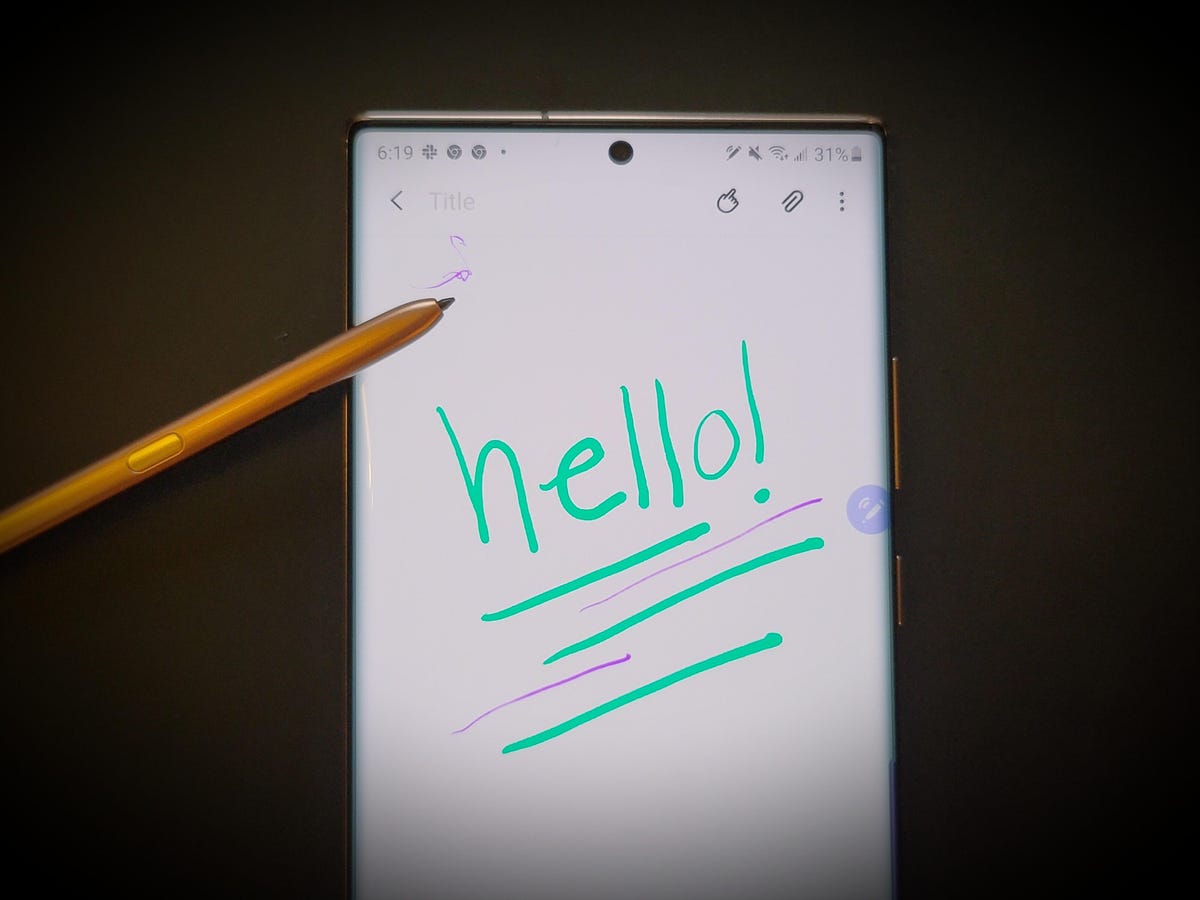

The S Pen writes better and faster on the Note 20 Ultra.
Jessica Dolcourt/CNET
Then there are the five new air gestures, which felt gimmicky. They’re customizable — a good thing, but I never figured out how to naturally incorporate them into days spent at home, and your movements have to be slow and deliberate to get the gestures right.
My favorite S Pen tricks are oldies-but-goodies:
- Using the S Pen to sketch a concept
- Magnifying tiny font on a page
- Annotating anything and everything
- Taking precise screenshots and highlighting just the exact text I want to copy and paste
- Taking a selfie by pressing the S Pen button
What’s the Note 20 Ultra’s processor like?
The Qualcomm Snapdragon 865 Plus processor on my Note 20 Ultra review unit is, in a word, snappy. Extremely fast, totally competent, nothing got in its way. Benchmarking scores were also top-notch. However, some regions use Samsung’s house-made Exynos 990 chipset, which is the same as the Galaxy S20 line. (The Note 20 Ultra with Exynos also has 256GB storage versus the 128GB of my configuration.) I haven’t had a chance to test the Exynos version, but will update this with insight from my colleague in the UK.
Note 20 and Note 20 Ultra specs
Galaxy Note 20 vs. Note 20 Ultra
| Samsung Galaxy Note 20 | Samsung Galaxy Note 20 Ultra | |
| Display size, resolution | 6.7 inches; 2,400×1,080 pixels | 6.9 inches; 3,088×1,440 pixels |
| Pixel density | 393 ppi | 496 ppi |
| Dimensions (inches) | 6.36×2.96×0.33 in | 6.49×3.04×0.31 in |
| Dimensions (millimeters) | 161.6×75.2×8.3mm | 164.8×77.2×8.1mm |
| Weight (ounces, grams) | 6.84 oz, 194g | 7.33 oz, 208g |
| Mobile software | Android 10 | Android 10 |
| Camera | 12-megapixel (ultrawide), 12-megapixel (wide-angle), 64-megapixel (telephoto) | 12-megapixel (ultrawide), 108-megapixel (wide-angle), 12-megapixel (telephoto) |
| Front-facing camera | 10-megapixel | 10-megapixel |
| Video capture | 8K | 8K |
| Processor | Snapdragon 865 Plus | Snapdragon 865 Plus |
| Storage | 128GB | 128GB, 512GB |
| RAM | 8GB | 12GB |
| Expandable storage | No | Up to 1TB |
| Battery | 4,300 mAh | 4,500 mAh |
| Fingerprint sensor | In-screen | In-screen |
| Connector | USB-C | USB-C |
| Headphone jack | No | No |
| Special features | S Pen stylus; 5G connectivity; Wireless PowerShare; water-resistant (IP68) | 5x optical zoom, UWB sharing, S Pen stylus; 5G connectivity; Wireless PowerShare; water-resistant (IP68) |
| Price off-contract (USD) | $1,000 | $1,300 (128GB); $1,450 (512GB) |
| Price (GBP) | £849 | £1,179 |
| Price (AUD) | AU$1,499 | AU$1,849 |
First published Aug. 18.
The post Galaxy Note 20 Ultra review: Amazing features, but is anyone a ‘power user’ anymore? first appeared on Joggingvideo.com.
]]>The post iPhone 12 screen aced our drop test. But this rival says its ‘glass’ is 3 times harder first appeared on Joggingvideo.com.
]]>
No sooner has the dust settled on CNET’s jaw-dropping iPhone 12 drop test than another rival has stepped up to claim its alternative “glass” for protecting electronics like phones and smartwatches is three times harder than the iPhone’s ceramic screen. Why? Because it’s made of diamond. Specifically, diamond glass.
Let’s back up for a minute. The iPhone 12 uses a brand-new material to protect its delicate display (that’s the panel beneath the “glass” that lights up the pixels you see on your screen). Called Ceramic Shield, the new glass topper is made by Corning, the same company that makes the new Gorilla Glass Victus cover material used on Samsung’s Galaxy Note 20 Ultra.
Apple, which worked with Corning to formulate Ceramic Shield just for the iPhone, claims this substance is “tougher than any smartphone glass.” Based on the results of our drop test, that could well be true.


Miraj Diamond Glass looks like “regular” glass.
Akhan Semiconductor
Ceramic Shield is a type of translucent, chemically strengthened glass that’s superheated until it’s incredibly hard. So what’s diamond glass? From the samples we’ve seen over the last several years, diamond glass is also just as transparent and reflective as you’d want from the top layer protecting your electronics.
But since it’s made from crystalline diamond, one of the hardest known structures, manufacturers have looked to the substance as an alternative to “regular” glass, which can still crack, break and scratch despite undergoing a process to chemically strength it.
This material in particular, called Miraj Diamond Glass, uses lab-grown diamond nanomaterials that are so incredibly small, they can be sprayed in an ultrathin layer on top of either glass or plastic to make a much harder surface. In theory, Miraj Diamond Glass could even top ultrathin foldable glass like the kind found on the Galaxy Z Fold 2.
On paper, diamond glass is inherently harder than ceramic glass like the iPhone 12’s Ceramic Shield and Schott Ceran Miradur, which is used on cooktops, simply because the properties of diamond nanocrystal will score higher on industry-standard scales of hardness and pressure than ceramic glass. Schott’s website even claims its ceramic glass is “almost as hard as a diamond” (my emphasis).


Now playing:
Watch this:
iPhone 12: How tough is the glass?
14:47
To prove the advantage of its material — which is not yet available in a commercial product — Akhan Semiconductor commissioned a lab at Northwestern University that works with nanotechnology to use microindentation testing, a standard way to examine a material’s hardness at a microscopic level, using an indenter tool made from none other than diamond, one of the hardest materials on Earth.
The result? The claim that Miraj Diamond Glass cover material sprayed onto ceramic glass is over three times harder than any ceramic glass alone could ever be — including the iPhone 12’s topper. (According to Akhan Semiconductor’s graph, below, ceramic glass measures no more than 10 Gigapascals, a unit of pressure, compared to diamond glass, which measure over 36 Gigapascals.)
But here’s a catch. The lab’s microindentation test occurred before Apple launched the iPhone 12, which means that the claim remains theoretical for now. The true test would be a one-to-one comparison of Miraj Diamond Glass and Corning’s Ceramic Shield on the same device — in this case, two iPhone 12 devices, one as is and the other coated in an extra layer of hardened diamond dust.
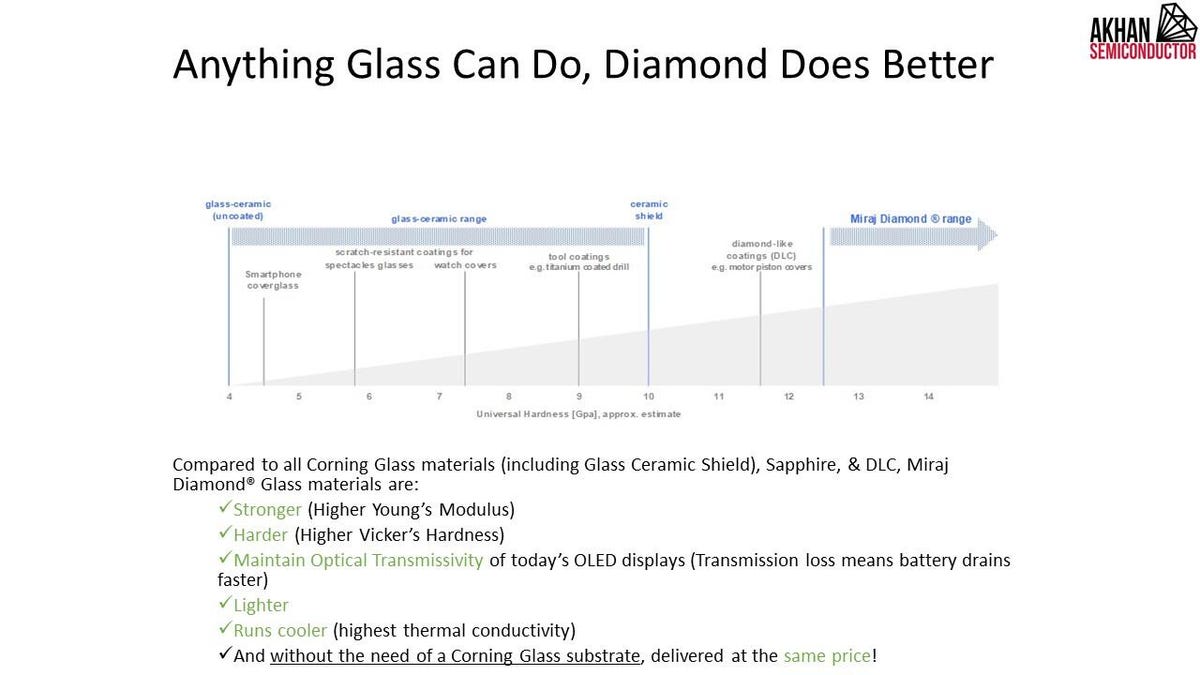

A visual scale of material properties for “hardness,” as measured by gigapascals, a unit of pressure.
Akhan Semiconductor
That said, a microindentation test is only one measure of hardness, and one way to test all-around durability and strength. Drop tests, scratch tests and other torture tests would paint a more complete picture of how diamond glass would hold up against your real life accidents and abuses, including drops, scratches and other kinds of physical or temperature pressure.
We know that a material itself may behave one way when it’s a flat rectangle on a piece of steel. But putting it on a device that curves, bends and stretches in spots can also change the forces that cause a material to act one way or another.
That’s one reason why the corners of a phone screen often seem more susceptible to cracks and scratches, and it’s what makes these real world exercises so important. Diamond glass has been one promising glass alternative for the last several years. But until it sees daylight on a commercial device, it won’t have a chance to truly shine.
The post iPhone 12 screen aced our drop test. But this rival says its ‘glass’ is 3 times harder first appeared on Joggingvideo.com.
]]>The post Galaxy S20 vs. S20 Ultra vs. S20 Plus: Who should buy which Samsung phone first appeared on Joggingvideo.com.
]]>
As the tech world buzzes about Samsung’s newest devices — the Galaxy Note 20, Note 20 Ultra, Galaxy Fold 2 and Galaxy S20 FE — now might be a great time to revisit the lineup Samsung announced at their first Samsung Unpacked event of 2020, back in February. A lot has changed since the unveiling of the Galaxy S20 line. As the coronavirus pandemic grew, smartphone shipments around the world plunged 38% in February. The timing is admittedly odd. Shopping for a new phone like the Samsung S20 Ultra, S20 Plus or standard Galaxy S20 in the midst of a global public health crisis may not seem like your first instinct or inclination. But the S20 Ultra is already on sale from its original launch price, and if more price cuts are on the horizon as Samsung shifts focus to the Note 20 and Fold 2, the price could be right for one of its flagship phones from earlier this year.
Read more: Here’s how the new Galaxy S20 FE compares to the rest of the S20 line
Keep an eye out for discounts and bundles, and in the meantime, find out which Galaxy S20 is best for you. We start with the main differences among the models, each phone’s biggest benefits and which one excels at the most important categories. Scroll to the end to compare specs.
Read more: This year should have been huge for phones. Now Samsung and others face a crossroads


Now playing:
Watch this:
Galaxy S20 vs. S20 Plus: Which Samsung phone to buy
8:19
Which Galaxy S20 is which?
The Galaxy S20 trio is about more than just a scale of smallest and cheapest to largest and most expensive. They share commonalities, like a sharp, vibrant screen technology, Android 10 software and a 120Hz screen refresh rate that can make scrolling and gameplay liquid smooth. (Warning: It can also eat up battery reserves.)
But there are some notable differences between them in specs, performance and maneuverability that affect how they fare in day to day use.
Here are some main differences:
- Galaxy S20 Ultra: 6.9-inch screen, heavy and bulky, most camera features, fastest 5G
- Galaxy S20 Plus: 6.7-inch screen, slightly scaled back camera, fastest 5G
- Galaxy S20: 6.2-inch screen, same camera as Plus, slower 5G except for Verizon
See the Galaxy S20’s best tips and tricks
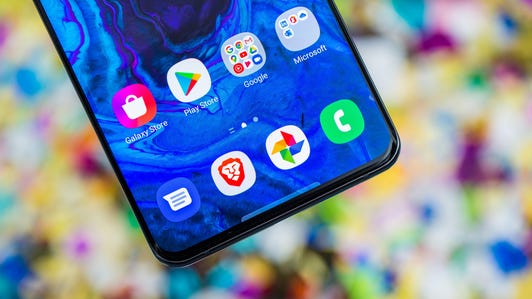



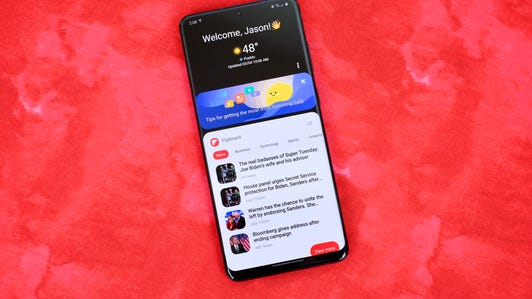

+7 more
Buy the Galaxy S20 Ultra if…
- You love an enormous screen
- Price is not a consideration
- You enjoy every camera whistle and bell
Galaxy S20 Ultra
$1,123 at Amazon
Buy the Galaxy S20 Plus if…
- You like a large screen
- Want to access the fastest form of 5G
- Seek long battery life
Galaxy S20 Plus
$1,200 at Best Buy
Buy the Galaxy S20 if…
- You prefer a smaller phone
- Fastest 5G speeds aren’t a priority
- Value for money is an important consideration
Galaxy S20
$1,000 at Best Buy
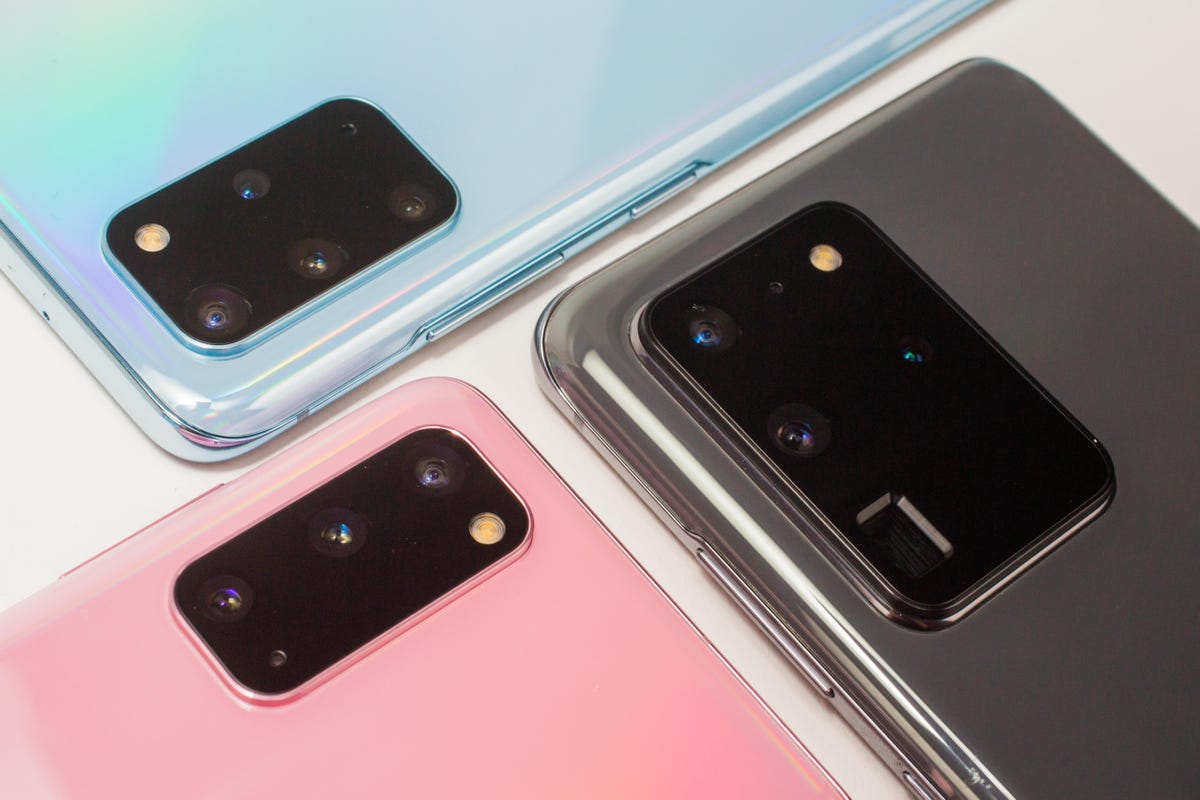

The differences between Galaxy S20 phones go beyond price and size.
Sarah Tew/CNET
Best screen experience: Galaxy S20 Ultra
The Galaxy S20 Ultra is personally my least favorite of the three. It’s too expensive for what it is (at launch, the price started at $1,399, £1,199 or AU$1,999), and it feels like a literal brick (7.8 ounces or 220 grams). But I can’t deny that its screen size makes it the best S20 for watching videos and reading the internet, simply because of its larger screen.
Resolution is actually the lowest of the S20 phones, but its pixel density is so high, I doubt you’ll notice.
Most powerful camera: Ultra, but…
On paper, the Ultra wins here. It has two features unique to the Galaxy S20 line: a 108-megapixel main camera that works through a process called pixel binning (read that article, it’s fascinating), and up to 100x zoom.
That sounds impressive, and the technology is intriguing. In reality, though, I rarely yearned for either feature, and I don’t miss them when I’m using another phone. To use the 108-megapixel setting, you must first tap a setting, take the photo and then, in editing mode, crop in. The purpose is to get a detailed picture using this method than you might otherwise get from the main camera alone, especially if you can’t get close to the subject. It’s a roundabout way to zoom in on a shot.


The thick, heavy Ultra wants to be the camera king.
Juan Garzon/CNET
Using the 100x zoom is much more straightforward, but unless you really, really need to get that close, the resulting image will be grainy and barely usable. It works better the farther from the subject you are.
Meanwhile, the 12-megapixel main camera, 64-megapixel telephoto sensor and the 30x zoom on the S20 Plus and S20 did just what they needed to do. You can still take a 64-megapixel photo and crop in for more detail, though this process doesn’t use pixel binning. (See the comparison chart below for more camera specs.)
Longest battery life: Still up in the air
Two factors determine battery life on the Galaxy S20 phones: If you’re on 4G or 5G, and if you’re using the 60Hz refresh rate (default) or have turned on the 120Hz option. I tested all three phones over 4G, because 5G wasn’t available where I was testing. I also observed battery conditions in the real world with both the 60Hz and 120Hz screen settings for all three phones.
This is where it gets a little messy. I can’t comment on how 5G factors in yet, but in general, the use of 5G can lower battery life. And CNET’s comprehensive lab tests — in airplane mode and over Wi-Fi, and with 60Hz and 120Hz screen selections — have been temporarily interrupted as we all adjust to quarantine life. They will resume.
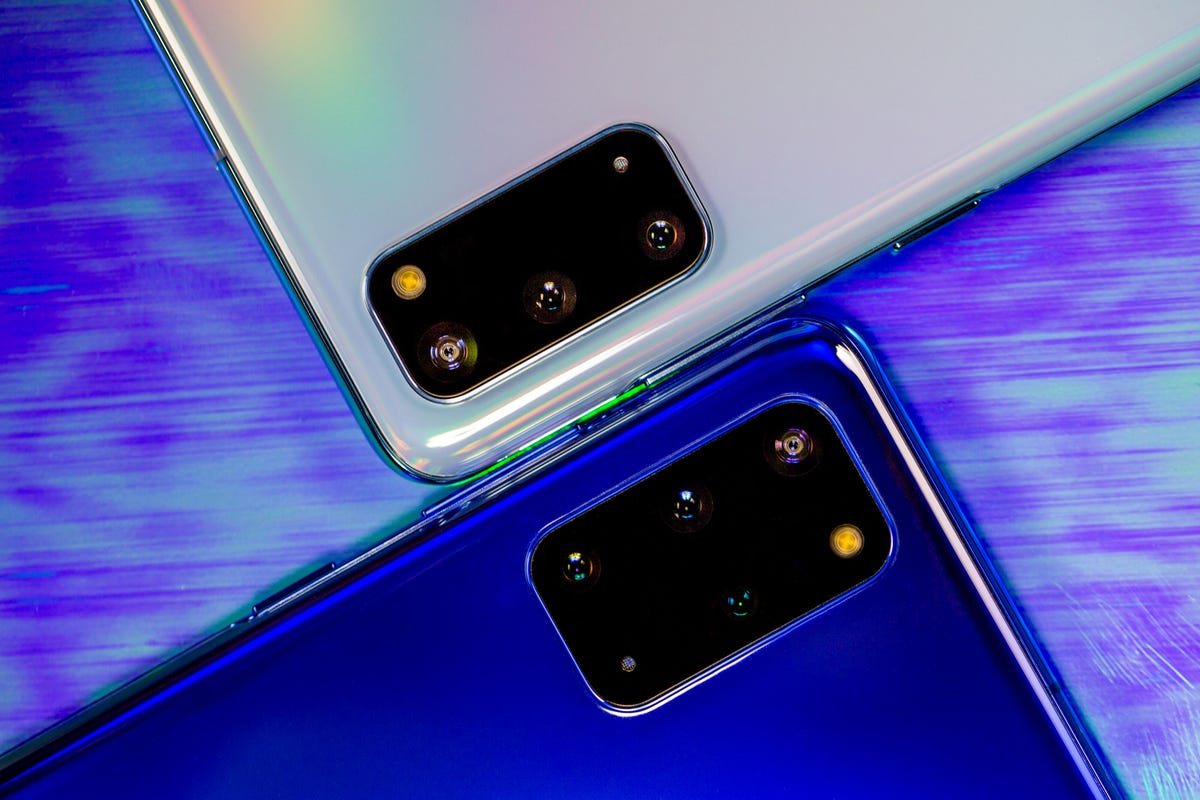

All the Galaxy S20 phones support wireless charging and reverse wireless charging to another device.
Angela Lang/CNET
In the meantime, I can tell you that despite having the largest battery reserves (5,000 mAh), I was surprised that the Ultra’s battery life drained quickly for me when I used the 120Hz refresh rate option.
Meanwhile, the Galaxy S20 Plus’ smaller battery (4,500 mAh) lasted just as long as the S20 Ultra in the CNET lab tests we were able to conduct. The Galaxy S20 (4,000 mAh) and S20 Plus have both lasted me from morning till night, though if you tap into 5G data and use the 120Hz option round the clock, you may need to top up before going out for a long night — probably not a priority these days.


Now playing:
Watch this:
Comparing the iPhone 11 Pro Max camera to the Galaxy…
7:49
Best 5G: A draw
The Galaxy S20 Ultra and S20 Plus both support the type of ultrafast 5G data transfer called millimeter wave (aka mmWave). The Galaxy S20 relies on the form of 5G loosely referred to as midband, or Sub-6. Midband 5G has relatively lower peak speeds, but is designed to travel greater distances and be more accessible indoors. Remember, even “slow” 5G is still expected to give you faster data transfer than 4G speeds.
There are exceptions, however. Verizon announced it would release a variant of the Galaxy S20 5G phone that does work with its mmWave network — we just don’t have an exact date yet. In some countries, such as the UK and Australia, you can buy 4G-only versions of the Galaxy S20, as well.
That makes 5G a potentially deciding factor between, say, buying the Galaxy S20 and the Galaxy S20 Plus. If you’re looking to future-proof your phone as much as possible, the S20 Plus is the logical choice. If the networks in your area are slower on the draw and 5G won’t be fully developed where you live for several years, then you’ll hardly miss out with a 4G or 5G Galaxy S20.
Galaxy S20 shines in bright, pastel colors




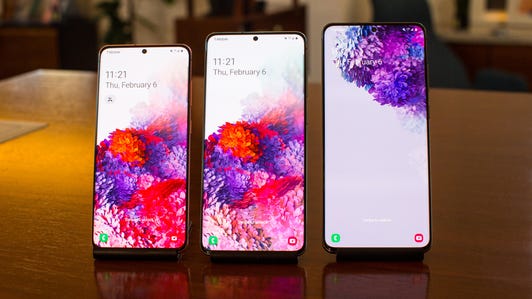

+29 more
Best value for money: Galaxy S20
By virtue of its lower price, the Galaxy S20 is the best value for money, but that’s hardly a blanket statement. The entry-level device costs $1,000 at full retail price in the US, which is significantly more than other entry-level phones like the iPhone 11, which starts at $699.
Even the $950 Galaxy Note 10 is less than the S20. Samsung justifies the price hike with the 120Hz screen and camera features, even though the image quality, while very good, didn’t demolish the competition. If Samsung, retailers and carriers offer compelling deals and bundles, this is going to be the phone that will be put in the best position to compete.
Galaxy S20 vs. S20 Plus vs. S20 Ultra
| Samsung Galaxy S20 | Samsung Galaxy S20 Plus | Samsung Galaxy S20 Ultra | |
|---|---|---|---|
| Display size, resolution | 6.2-inch Dynamic AMOLED 2X | 6.7-inch Dynamic AMOLED 2X | 6.9-inch Dynamic AMOLED 2X |
| Pixel density | 563ppi | 525ppi | 511ppi |
| Dimensions (Inches) | 2.72 x 5.97 x 0.311 in | 2.9 x 6.37 x 0.30 in | 2.99 x 6.57 x 0.35 in |
| Dimensions (Millimeters) | 69.1 x 151.7 x 7.9 mm | 73.7 x 161.9 x 7.8mm | 76.0 x 166.9 x 8.8mm |
| Weight (Ounces, Grams) | 5.75 oz; 163g | 6.56 oz; 186g | 7.76 oz; 220g |
| Mobile software | Android 10 | Android 10 | Android 10 |
| Camera | 12-megapixel (wide-angle), 64-megapixel (telephoto), 12-megapixel (ultra-wide) | 12-megapixel (wide-angle), 64-megapixel (telephoto), 12-megapixel (ultra-wide), time-of-flight camera | 108-megapixel (wide-angle), 48-megapixel (telephoto), 12-megapixel (ultra-wide), time-of-flight camera |
| Front-facing camera | 10-megapixel | 10-megapixel | 40-megapixel |
| Video capture | 8K | 8K | 8K |
| Processor | 64-bit octa-core processor (Max 2.7 + 2.5 + 2GHz) | 64-bit octa-core processor (Max 2.7 + 2.5 + 2GHz) | 64-bit octa-core processor (Max 2.7 + 2.5 + 2GHz) |
| Storage | 128GB | 128GB, 512GB | 128GB, 512GB |
| RAM | 12GB | 12GB | 12GB, 16GB |
| Expandable storage | Up to 1TB | Up to 1TB | Up to 1TB |
| Battery | 4,000 mAh | 4,500 mAh | 5,000 mAh |
| Fingerprint sensor | In-screen | In-screen | In-screen |
| Connector | USB-C | USB-C | USB-C |
| Headphone jack | No | No | No |
| Special features | 5G enabled; 120Hz refresh rate; water resistant (IP68) | 5G enabled; 120Hz refresh rate; water resistant (IP68) | 5G enabled; 120Hz refresh rate; 100X zoom; water resistant (IP68) |
| Price off-contract (USD) | $999 | $1,199 | $1,399 (128GB), $1,599 (512GB) |
| Price (GBP) | £799, £899 (5G) | £999 (5G) | £1,199 (128GB), £1,399 (512GB) |
| Price (AUD) | AU$1349 (4G), AU$1,499 (5G), | AU$1,499 (4G), AU$1,649 (128GB), AU$1,899 (512GB) | AU$1,999 (128GB), AU$2,249 (512GB) |
The post Galaxy S20 vs. S20 Ultra vs. S20 Plus: Who should buy which Samsung phone first appeared on Joggingvideo.com.
]]>The post Galaxy Z Fold 2: All the ways this foldable do first appeared on Joggingvideo.com.
]]>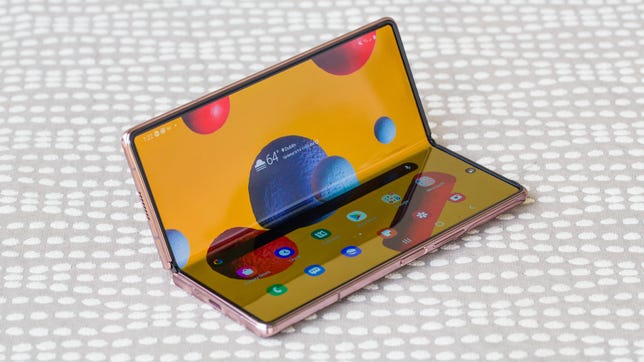
8.1
Samsung Galaxy Z Fold 2 5G
$1,899 at Amazon
Get Price Alerts
You’re receiving price alerts for Samsung Galaxy Z Fold 2 5G
Like
- Refined look and feel
- Sits open at multiple angles
- Fixes nearly every flaw from the original
Don’t Like
- Inner screen still fragile
- Fingerprint unlock errors too numerous
- Typing can feel cumbersome
The Galaxy Z Fold 2 is not just a foldable phone. It’s a movement waiting to happen. Samsung’s winning do-over of its first foldable design improves on the original Galaxy Fold in nearly every way. It starts at the new 6.2-inch outer screen and moves on to the 7.6-inch inner display, and every hinge part, notch and crevice in between, delivering a high-end device that for the first time draws a full-size foldable phone from the realm of fantasy to the edge of reality.
Samsung’s original Galaxy Fold was a bold concept with terrible execution. Besieged by problems and pitfalls at nearly every turn, Samsung had to redesign the device after review models broke in multiple ways, causing the brand to lose distribution partners, drop color options and deliver the foldable device four months late.
Read more: Galaxy Z Fold 3: Samsung foldable gets S Pen support, water resistance and a price drop
The Z Fold 2 may keep the same shape as the original, but it exudes confidence and competence that the first design lacked — with one exception. CNET Section Editor Juan Garzon’s review unit has a bubbled interior screen, which would clearly fall under Samsung’s warranty if a purchased product arrived damaged. The review unit I’ve been using hasn’t experienced any issues. CNET has reached out to Samsung to report the problem.


Now playing:
Watch this:
Galaxy Z Fold 2: The new foldable phone king
13:34
When I look at the Galaxy Z Fold 2’s large outer display (6.2 inches), sturdy hinge and upleveled multitasking skills, I see a foldable phone striving to define the intersection of smartphone luxury and technical innovation, but with a utility that banishes the suggestion of gimmick. For example, the Z Fold 2 replaced my laptop for 28 hours and did nearly everything I needed, though writing and editing admittedly took longer tapping out on a screen than typing on keyboard squares.
The Z Fold 2 isn’t a phone for everyone — its $2,000 (£1,799, AU$2,999) price puts it out of range for many — but it’s a device that deserves and demands your attention.
Read on for the best and worst Z Fold 2 features, and everything you need to know about camera, battery life and Samsung’s VIP treatment. You’ll find the full specs comparison with the Galaxy Note 20 Ultra, Galaxy Fold and Microsoft Surface Duo at the end.
Galaxy Z Fold 2: Samsung’s most luxe foldable phone yet






+28 more
8 best improvements to the Galaxy Z Fold 2
- Premium look and feel
- Hinge mechanism is sturdy and smooth as you open and close the device
- No gaps between the screen and body (I tried with my fingernail. All sealed.)
- 6.2-inch external screen takes up most of the exterior footprint
- Ultrathin glass on the inner screen instead of plastic adhesive alone
- Support for 120Hz refresh rate (inner screen)
- No notch on 7.2-inch interior display
- Apps seamlessly switch between inner and outer displays
How the Z Fold 2 could be even better
- Inner screen isn’t waterproof, requires special care instructions
- Reflection on the screen crease is noticeable when hinge stays open
- Heavy, with sharp edges. Grows wearisome to hold during long-term use
- Better cameras, including a 5x optical zoom
- A more accurate fingerprint reader (more below)
- Apps can raise the bar on conforming to the screen (more below)
- Support for Work Profile apps in the multitasking view (more below)
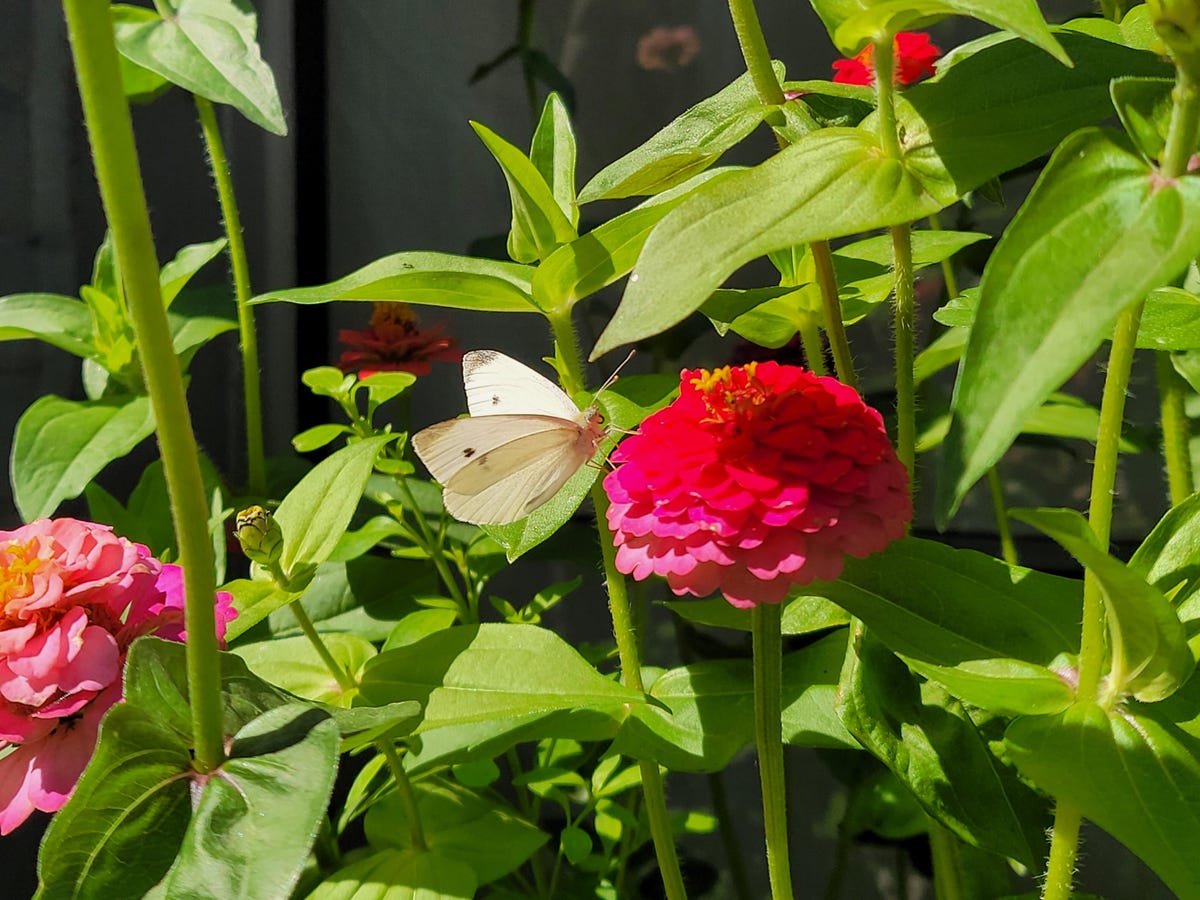
Taken with the Galaxy Z Fold 2’s 2x optical camera.
Jessica Dolcourt/CNET
Z Fold 2 cameras are good, but Note 20 Ultra’s are better
Photography on the Z Fold 2 leaves little to complain about, unless you’ve just used the Galaxy Note 20 Ultra as your primary phone, like I have.
That device, which costs $1,300 retail, has 5x optical zoom that the Z Fold 2’s 2x optical zoom wishes it could be, and a few other fancy features that I could usually take or leave. Zooming into architectural features on a day trip to San Francisco, or seeing animals in nature, was a lot less satisfying on the Z Fold 2 compared to the Ultra.


A beautiful view of San Francisco’s iconic Ferry Building on a beautiful day, but the Z Fold 2’s 2x optical zoom is no match for 5x if we wanted to get a little more close and personal.
Jessica Dolcourt/CNET
Photos are still good — very good, even — but this isn’t the most superior camera phone that Samsung makes. There are pro photo and pro video modes, which bring it up to date, and I do like being able to unfold the device to take a higher-quality selfie with the rear cameras.
The Z Fold 2’s outer screen serves as a viewfinder if you tap the right onscreen control, but it’s awkward to hold the phone this way while taking a photo, and everything looks slightly off-kilter if you’re looking at yourself onscreen and not the camera sensor. I also noticed that a lot of my standard photos seemed ever so slightly askew. Reviewing pictures on the 7.6-inch screen, though, is a dream.
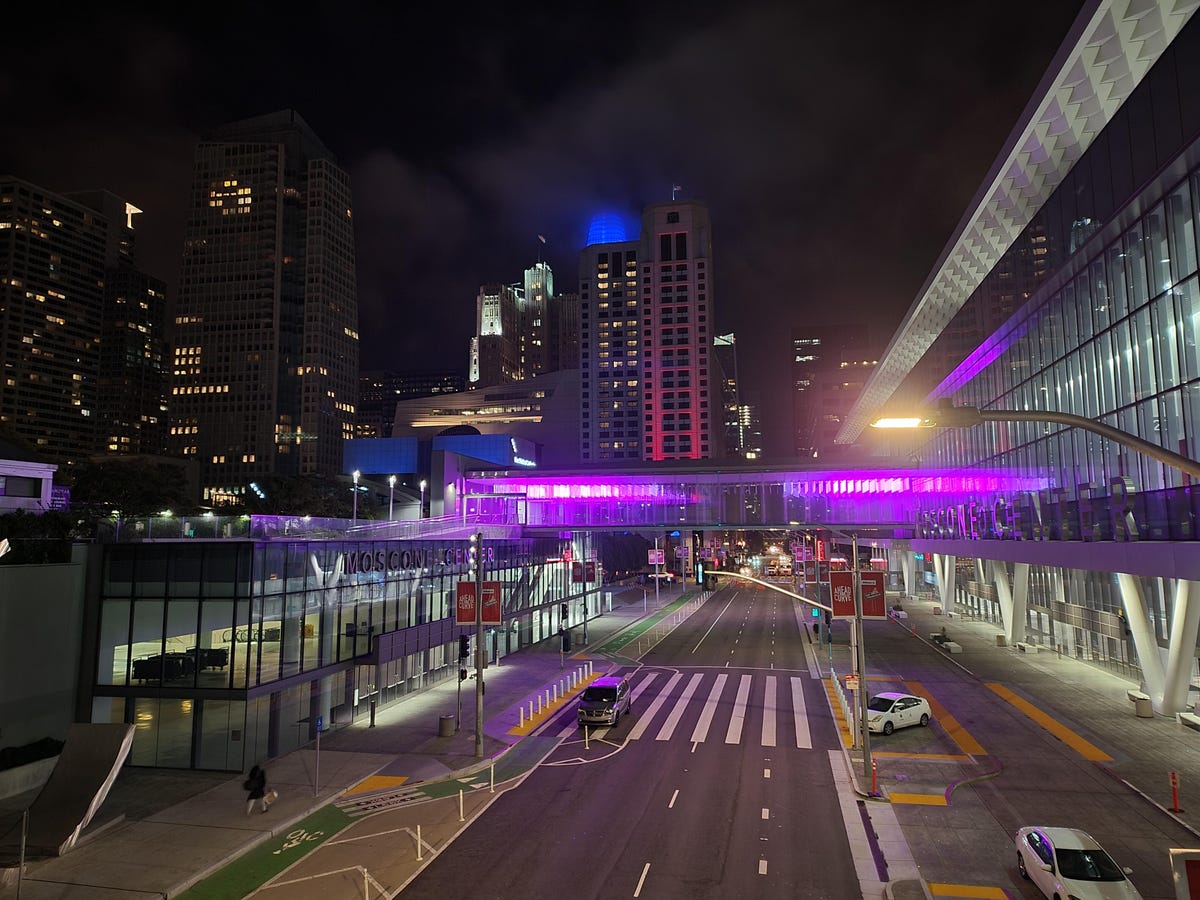

San Francisco street, using night mode.
Jessica Dolcourt/CNET
Flex Mode: Highs and lows of the self-supporting hinge
I genuinely thought Flex Mode would be the Z Fold 2’s killer feature, but it didn’t quite work out as expected. Flex Mode is Samsung’s way to describe the state of the Z Fold 2 when you bend the two screens in between totally closed and fully open, and the two “sides” stay where they are.
The benefits are plenty real. The phone can prop itself open from a range of at least 75 to 115 degrees, which means it can become its own stand vertically or horizontally, and some apps can shift to take advantage of the new dimensions. That essentially splits the interface so that, for example, you can see a video on “top” and other navigation options on the “bottom.”
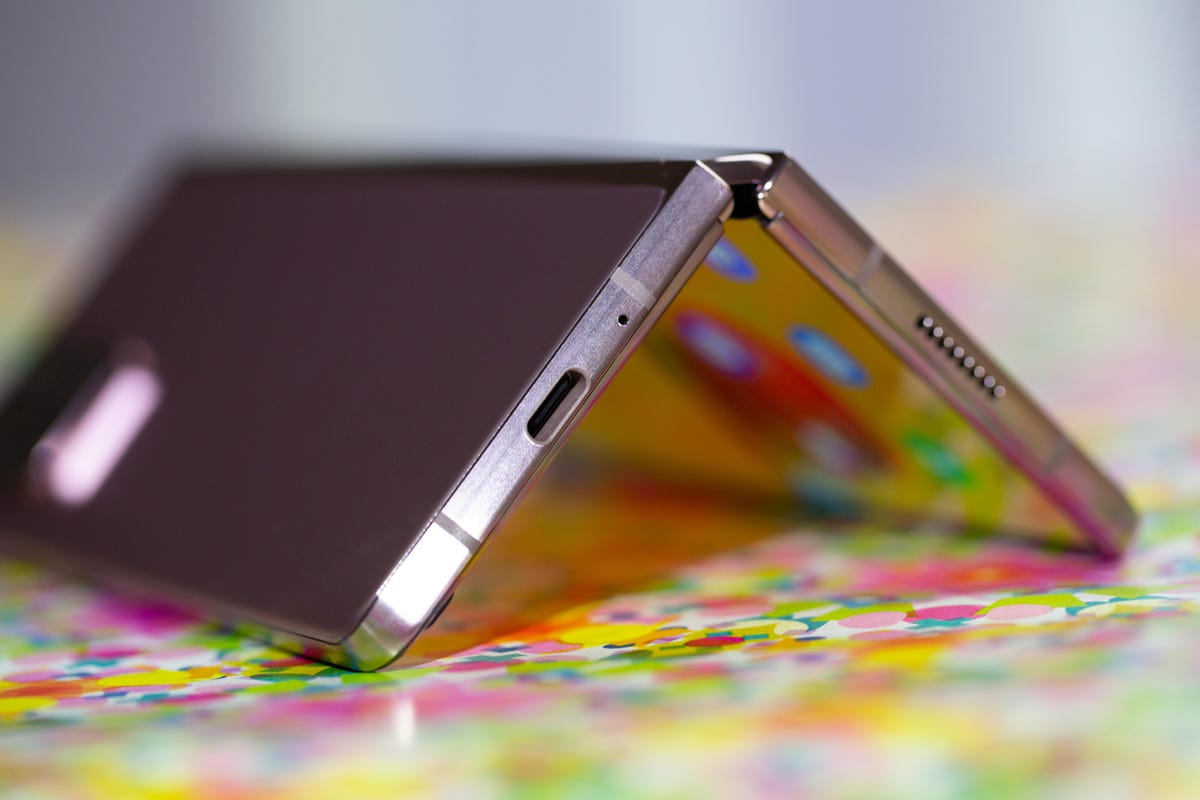

The Z Fold 2’s hinge can keep its shape from 75 to 115 degrees without snapping shut or flopping open.
Angela Lang/CNET
But there aren’t enough apps yet that recognize the long, narrow dimensions and know how to use them well. And the natural screen ratios when you bend the phone in half work more cohesively on the smaller Galaxy Z Flip than they do on the Z Fold 2.
For example, when the Z Flip bends in half, it forms two squares. The bottom creates a stand and the top has a centered video camera that’s intuitive to use for video calls, reading, watching videos and framing photos from front and rear cameras.
Meanwhile, the angles on the Z Fold 2 never felt quite right for most of those. Samsung says there are more apps coming to take advantage of the split-screen design — I certainly hope that’s the case.
Battery life better than I feared
I worried about the Z Fold 2’s ability to deliver all-day battery life with its 4,500-mAh battery capacity. Note that these are two separate battery cells that together create the same total capacity as the Note 20 Ultra, a phone I thought had middling battery performance because of its resource-hungry 120Hz screen.
Now, add into the equation two battery cells that are generally thought of as less efficient than one big battery (because of battery chemistry) and a really big 7.6-inch screen that refreshes at twice the rate of a typical screen (using more battery) and you can understand the skepticism.
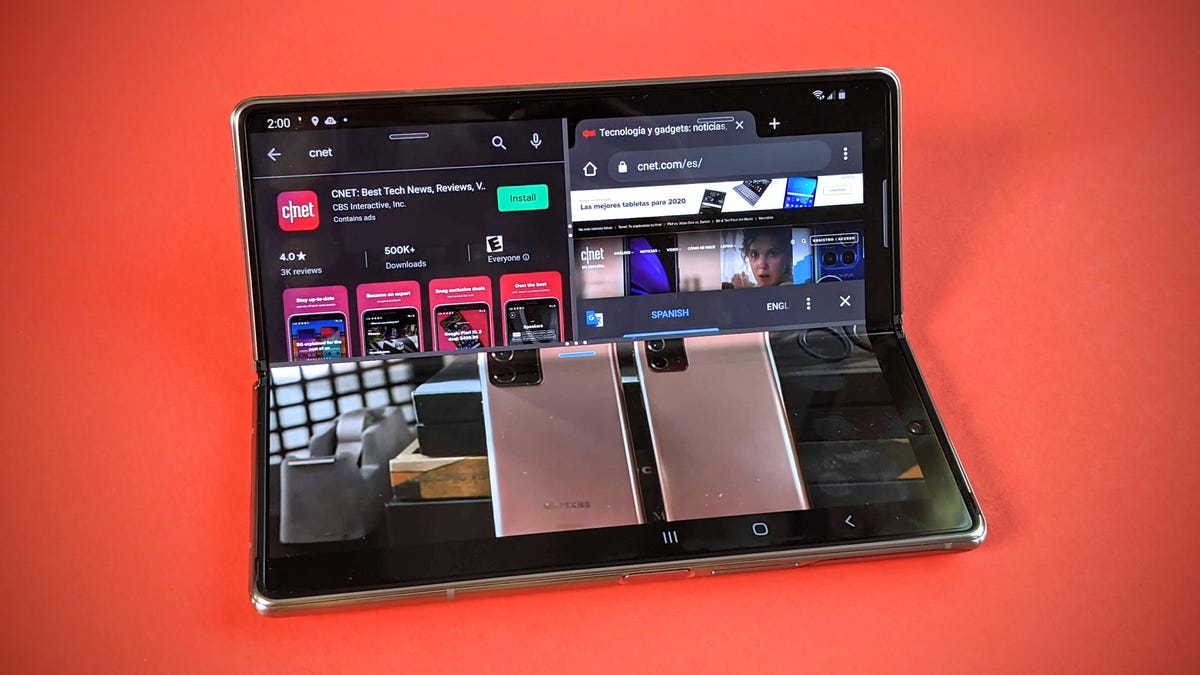

The power-hungry 7.6-inch inner screen supports a 120Hz refresh rate, which should drain the battery faster the more you use it. However, the Z Fold 2 should still last a day on a full charge.
Juan Garzon/CNET
However, the day I exchanged my laptop for a Z Fold 2, I used resource-hungry live maps navigation for 2 hours in a 28-hour period, browsed and messaged nonstop, watched hours of Netflix, took dozens of photos and so on. Even on this heavy day, I still managed to get from morning to evening on a single charge.
Part of that is because the 7.6-inch internal screen only uses 120Hz screen refresh rate on an “adaptive” cycle, which means it automatically flicks on when you’re doing something intensive enough to warrant the ultrasmooth scrolling, gaming and more. The rest of the time it reverts to 60Hz (like the outer screen, which I used at least 60% of the time), and which held reserves in check.
Battery life isn’t amazing, but it’s more than doable, and for a device like this, I consider that a positive. You can also manually switch the inner screen’s refresh rate to 60Hz and if you enter battery-saving mode, 120Hz will fall away.
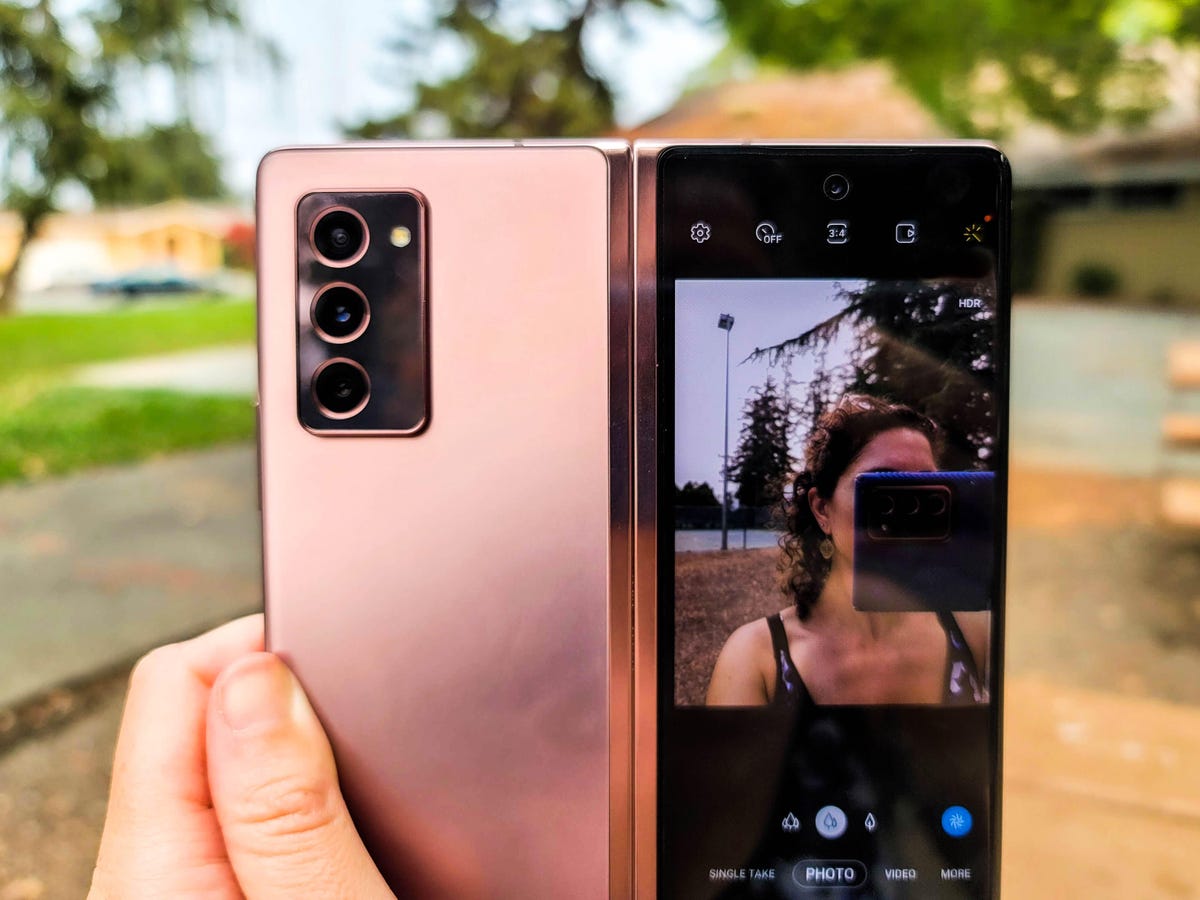

You can use the outer screen as a viewfinder for taking selfies from the main camera — neat trick.
Jessica Dolcourt/CNET
Multitasking, typing, app continuity: A mixed bag
Multitasking: I love Samsung’s new multi-window app feature — mostly — because it makes it so much easier to split the 7.6-inch screen into two or three zones to use apps at the same time. Dividing the screen this way felt natural and helpful for periods of time.
In this iteration, when you have one app open, you’re able to swipe out from the side menu, select an app and drag it into one of three locations: to the right or left pane, horizontally, bottom (a vertical position below the main window), or a pop up in the middle of what you’re looking at. This is great flexibility here.
Unfortunately, not every app you have installed works with this layout, including apps sandboxed in the “Work Profile” section of Samsung’s Knox security that works with corporate apps. It’s a shame, since the productivity apps are among the ones I want to multitask with the most.
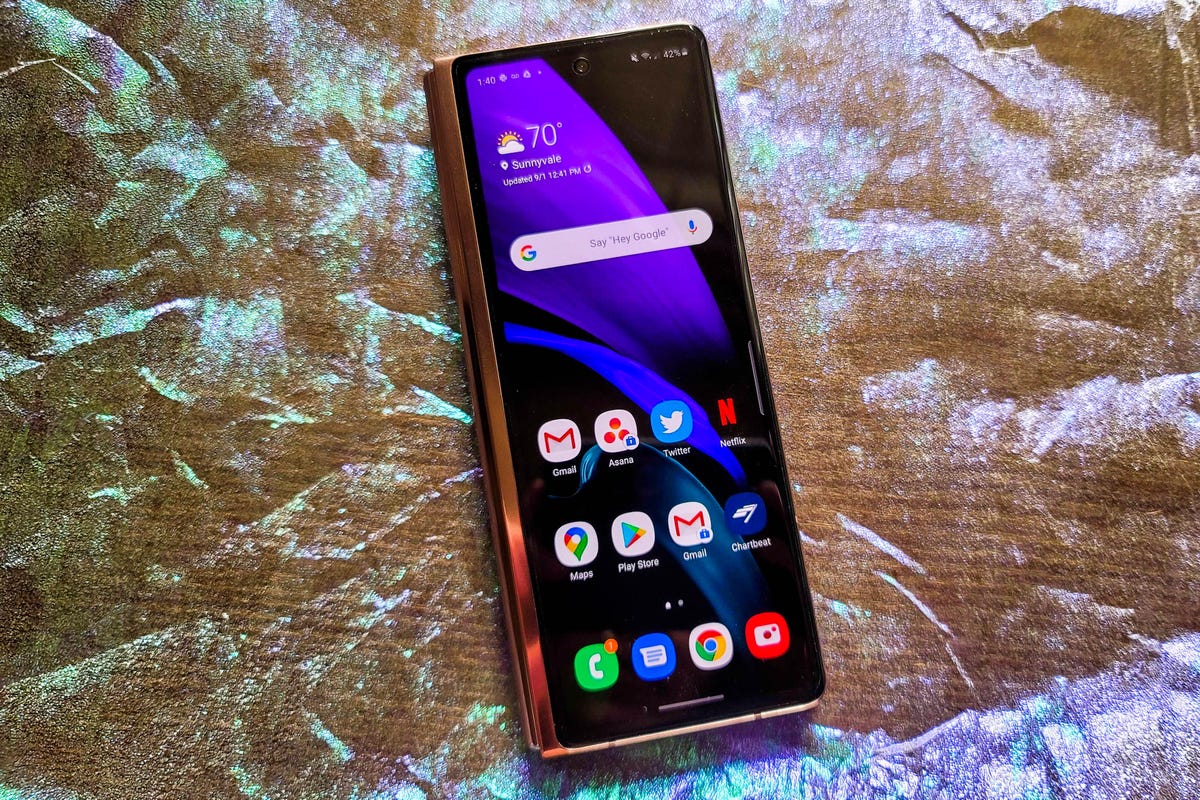

Any app you start on the outer screen seamlessly picks up where you left off when you open the Z Fold 2.
Jessica Dolcourt/CNET
App hand-off: I loved the liquidity with which apps from the inner and outer screen slid over to the other when I opened or closed the Z Fold 2. Any app you open the 6.2-inch outer screen, any app you have loaded will jump to the inner screen as you unfold the device — seamlessly. It’s a bit of work to dig into the settings to select which apps you want to go the other way when closing the larger inner screen, like a video (it will automatically work for calls). I will say, it’s completely worth the effort to set this up.
Typing: Once again, I have to commend Samsung for making a split screen keyboard for the interior Fold screen. The goal is to make typing more comfortable on a wider-than-usual device that’s most beneficial when it’s fully unfolded into tablet form.
However… my hands are on the smaller side, which means that even on the split-screen keyboard my paws feel stretched. There really aren’t third party apps to replace the default keyboard, which means I wind up collapsing the unfolded phone — bending it slightly toward the center — to get the two sides together and gain some typing relief. If your hands are larger, you may not mind as much, but it’s not a design for everyone.
Apps that work for the screen: Samsung is slowly but surely working on apps to take advantage of the Z Fold 2’s bendable design in any formation. For example, there’s drag and drop between Gmail, Chrome, Microsoft Outlook and Samsung native apps. Other apps, like YouTube video, will play nice with the configuration. But until this catches on for all, expect some bootstrapping to get it all how you like.
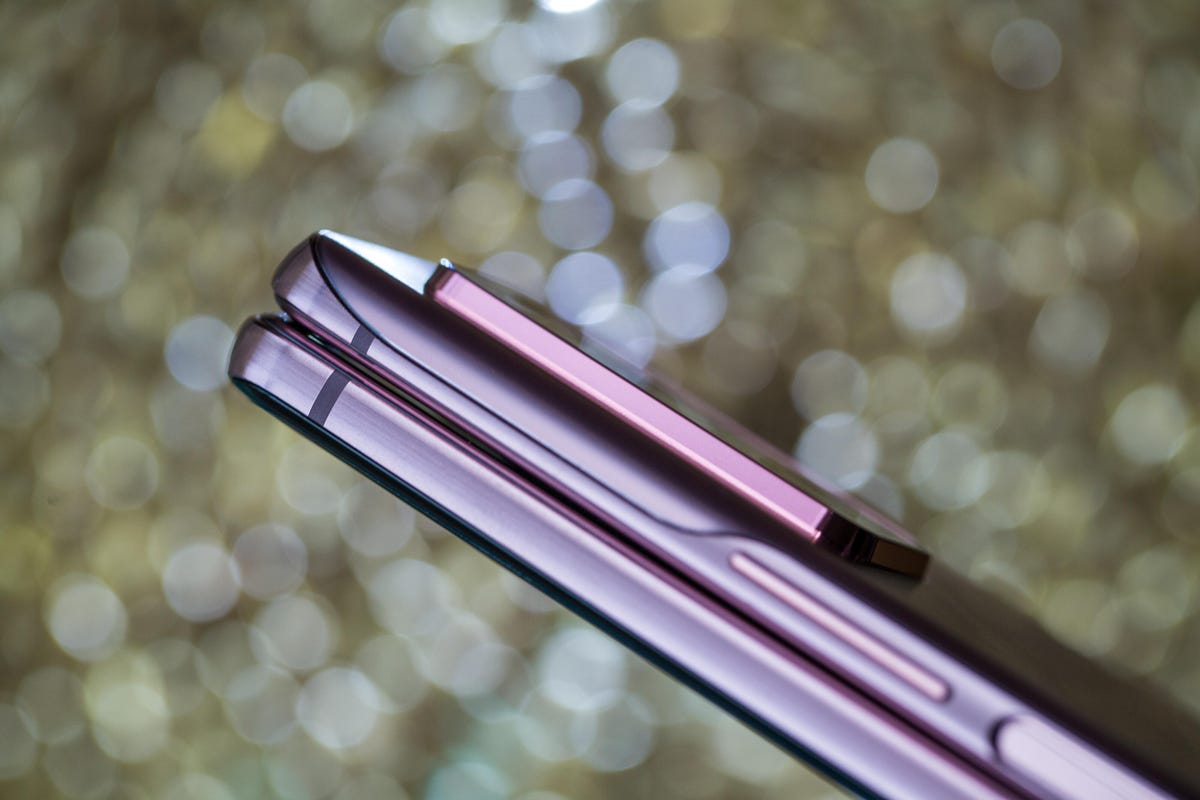

The fingerprint reader (at the bottom right of this photo) is hard to accurately hit when the phone is closed.
Angela Lang/CNET
Fingerprint reader not a deal breaker, but needs a fix
In the closed position, both new and original Galaxy Fold devices look like two phones stacked on top of the other in a delicious mobile sandwich. The downside — and weirdness — is that the fingerprint reader on the Z Fold 2’s power/lock button (on the right spine) is both completely sensible and also irrational.
Here’s what happens. You enroll up to four fingerprints when the phone is completely flat, unfurled (not folded in half), but if you try to unlock the device when it’s closed, your thumb has to find the precise angle and divot in the bottom portion of the stacked screen sandwich to unlock it without error or delay.
Despite this very convenient placement and setup, I had to punch in my backup credentials more times than not.
Should you get the Galaxy Z Fold 2?
A $2,000 phone isn’t a paltry affair, especially when 50% of the screens are fragile and finicky at best. But I have a completely different viewpoint than I did of the first Galaxy Fold — to the benefit of the successor. The Galaxy Fold was a mesmerizing beta phone, a blueprint, meant for the most dedicated of tech advocates living on the edge while Samsung and the rest of the industry worked out the details.


The Galaxy Z Fold 2 isn’t for everyone, but it does a lot to bring the future of foldable phones within reach.
Angela Lang/CNET
I still don’t think this $2,000 Z Fold 2 with its fragile screen is worth it for most, but it’s a lot closer to the kind of device everyday people might have and want than last year’s inchoate edition. As an ultrafancy phone, the Galaxy Z Fold 2 offers prestige and superior marksmanship for a do-everything phone of this type. As a tech-lover’s dream, it presents a grounded possibility that didn’t exist before.
Samsung’s VIP foldable Z Premiere treatment
Samsung has expanded its VIP club for foldable phones. Anyone who buys a Z Fold 2, Fold or Z Flip (including the new Z Flip 5G) gets access to the program.
- Galaxy Z Concierge program for on-demand customer service and consultation
- First-time screen replacement of $149
- Six months of LinkedIn Premium
- FoundersCard benefits: 12-month membership when you preorder. After launch, you get six months free
- A prepared meal from a Michelin starred restaurant through Tock
- Fairway Pass Elite through ClubCorp, which gives you access to golf clubs
- Six months of Obe Fitness online workouts
- $50 off Glamsquad in-home hair service
Galaxy Z Fold 2 vs. Microsoft Surface Duo vs. Galaxy Fold vs. Galaxy Z Flip
| Samsung Galaxy Z Fold 2 | Microsoft Surface Duo | Samsung Galaxy Fold | Samsung Galaxy Z Flip | |
| Display size, resolution | External 6.2-inch Dynamic AMOLED; Internal: 7.6-inch Dynamic AMOLED. External: 2,260×816 pixels. Internal: 2,208×1,768 pixels | Dual 5.6-inch AMOLED; 1,800×1,350 pixels. Combined: 8.1-inch AMOLED; 2,700×1,800 pixels | Internal: 7.3-inch Dynamic AMOLED; 2,152×1,536 pixels (plastic). External: 4.6-inch Dynamic AMOLED; 1,680×720 pixels (Gorilla Glass 6) | Internal: 6.7-inch FHD+ Dynamic AMOLED; 2,636×1,080 pixels. External: 1.1-inch Super AMOLED; 300×112 pixels |
| Pixel density | 386 + 373 ppi | 401 ppi | 362 ppi (internal screen) | 425 ppi (internal), 303 ppi (external) |
| Dimensions (Inches) | Folded: 2.67 x 6.26 x 0.6 in (hinge) ~ 0.54 in (sagging). Unfolded: 5.04 x 6.26 x 0.27 in (frame) ~ 0.23 in (screen) | Folded: 5.72 x 3.67 x 0.399 in. Unfolded: 5.72 x 7.36 x 0.19 in | Folded: 6.3 x 2.5 x 0.6 in. Unfolded: 6.3 x 4.6 x 0.3 in | Folded: 2.99 x 3.44 x 0.62 ~ 0.68 in. Unfolded: 2.99 x 6.59 x 0.27 ~0.28 in |
| Dimensions (Millimeters) | Folded: 68 x 159.2 x 16.8mm (hinge) ~ 13.8mm (sagging). Unfolded: 128.2 x 159.2 x 6.9mm (frame) ~ 6mm (screen) | Folded: 145.2 x 93.3 x 9.9 mm. Unfolded: 1,145.2 x 186.9 x 4.8 mm | Folded: 62.8 x 161 x 15.7mm ~ 17.1mm. Unfolded: 117.9 x 161 x 6.9mm ~ 7.6mm | Folded: 73.6 x 87.4 x 15.4 ~17.3 mm. Unfolded: 73.6 x 167.3 x 6.9 ~ 7.2 mm |
| Weight (Ounces, Grams) | 9.95 oz; 282 grams | 8.8 oz; 250g | 9.7 oz; 276g | 6.46 oz; 183g |
| Mobile software | Android 10 | Android 10 | Android 9.0 with Samsung One UI | Android 10 |
| Camera | 12-megapixel (main) + 12-megapixel (wide angle) + 12 megapixel (telephoto) | 11-megapixel | 12-megapixel (wide-angle), 16-megapixel (ultrawide-angle), 12-megapixel (telephoto) | 12-megapixel (wide-angle), 12-megapixel (ultrawide-angle) |
| Front-facing camera | 10-megapixel, 10-megapixel | Uses main camera | Two 10-megapixel, 8-megapixel 3D depth | 10-megapixel |
| Video capture | 4K | 4K | 4K (HDR 10+) | 4K (HDR 10+) |
| Processor | Snapdragon 865 Plus | Qualcomm Snapdragon 855 | Qualcomm Snapdragon 855 | Qualcomm Snapdragon 855+ (64-bit octa-core) |
| Storage | 256GB | 128GB, 256GB | 512GB | 256GB |
| RAM | 12GB | 6GB | 12GB | 8GB |
| Expandable storage | None | None | None | None |
| Battery | 4,500 mAh | 3,577 mAh | 4,380 mAh | 3,300 mAh |
| Fingerprint sensor | Side | Right side | Power button | Power button |
| Connector | USB-C | USB-C | USB-C | USB-C |
| Headphone jack | No | No | No | No |
| Special features | Foldable display, 120Hz refresh rate, wireless charging support, | Dual-screen display; dual-SIM capabilities (nano-SIM and e-SIM) | Foldable display, wireless charging, fast charging | Foldable display; wireless PowerShare; wireless charging; fast charging |
| Price off-contract (USD) | $2,000 | $1,400 | $1,980 | $1,380 |
| Price (GBP) | £1,799 | Converts to £1,080 | £2,000 | £1,300 |
| Price (AUD) | AU$2,999 | Converts to AU$1,915 | AU$2,950 | AU$2,999 |
First published Sept. 16
The post Galaxy Z Fold 2: All the ways this foldable do first appeared on Joggingvideo.com.
]]>The post Galaxy Z Fold 2: Impressive, but not perfect. Everything good and bad today first appeared on Joggingvideo.com.
]]>
I can’t stop looking at the Galaxy Z Fold 2. I keep catching myself glancing admiringly at its cool metal frame, 6.2-inch outer screen and thin bezels. The Z Fold 2 is such a complete, well-considered foldable phone, it’s now hard to think of the original Galaxy Fold as anything other than a working mockup with a ridiculous $1,980 price tag.
For $2,000 (£1,799 in the UK, which is about AU$3,270), that’s still big bucks, especially in our current world of coronavirus pandemic and global recession. But the more time I spend with the Z Fold 2, the more I’m convinced that this full-size foldable phone isn’t just a tech toy for wealthy early adopters. Even if most people would never dream of buying it, it’s exciting to follow along.
That in no way means this is a device for the regular person. The Galaxy Z Fold 2 is a niche, aspirational foldable phone that opens into a 7.6-inch tablet. it isn’t water-resistant. It comes with a long list of care instructions, and when I gripped its ultrathin screen to take a selfie using a special feature (more below), I worried my nails were clawing into the fragile glass. (It seems fine.)


Now playing:
Watch this:
Galaxy Z Fold 2: Hinge, cameras and durability revealed
7:58
But for a unique device that’s firmly on the cutting edge of technology, it has addressed every major flaw from the original Fold and refined it in the process, turning out a phone that — while I’m still getting to know — I could actually see using. It isn’t perfect, and there are still weak points I would like revised.
Galaxy Z Fold 2 preorders are open now and the phone goes on sale Sept. 18. Read on for everything I love so far and all the specs, hands-on photos and more. Since this is a developing review, keep in mind that opinions are subject to change as the review period progresses.
Best and worst Galaxy Z Fold 2 features so far
An external screen you can actually use. A larger, 6.2-inch display that takes up the entire outer screen looks great in closed position and makes the phone easier to use when you want to type quick replies one-handed or snap and immediately share a photo. I’ve already used it a lot this way in one day. Since the dimensions are tall and narrow, typing on the keyboard is still a pain, but it works.
Switching screens is fast and seamless. Maybe it’s the Qualcomm Snapdragon 865 Plus chipset or some tighter software controls, but switching from apps on the outer screen to the inner screen happens in a snap. I’ve tried it fast and opened the phone slowly to see at which angle whatever I’m viewing leaps off the outer screen and appears on the inner screen. When watching Netflix video, audio and visuals didn’t skip a beat. It’s great that Samsung lets you choose which apps you want to carry over on the outer screen when you snap the phone closed (e.g. to move to another room), but you have to dig into the settings to select them. Works like a charm.
Galaxy Z Fold 2: Samsung’s most luxe foldable phone yet






+28 more
Flexible hinge could be the killer feature, but… Using carryover technology from the much smaller Galaxy Z Flip, the Z Fold 2 is stiff enough for the two sides to stay open at a variety of angles (Samsung calls this Flex Mode), which means it can prop itself while you take a video call, watch the screen hands-free or shoot photos. This was the most stellar part of the Z Flip and could very well be the Z Fold 2’s most valuable and identifying feature. I’m using it as its own stand, but because of the screen configuration, I’m wondering if it’ll wind up being less useful than the Galaxy Z Flip’s square-shape screen when folded. We’ll see.
Internal glass screen has no notch, but feels fragile. Samsung’s most important change is to the internal screen. I’m thrilled Samsung stripped out the original Fold’s thumb-shaped notch, which gives the Z Fold 2’s internal screen much more usable real estate. At 7.6 inches unfolded, the Z Fold 2 features an ultrathin glass cover material that should be stronger than the Fold’s plastic display — and, crucially, less prone to phone-destroying damage.
There’s still a factory-installed screen protector on top, but Samsung’s redesign seems to shore up the gaps that could cause an object to get stuck in the hinge or under the display. For example, when I bend the Z Fold 2, what looks like a fall-through gap is actually plugged in with plastic, with no space for my fingernail to poke through. Progress, but you still have to baby the display and I worried about it working with just-washed hands and while cooking.
Multitasking on the Z Fold 2 has gotten smarter.
Samsung
Multitasking makes sense now, but still lacks total flexibility. Splitting the Z Fold 2’s large 7.6-inch display into multiple panes makes perfect sense for a device of this type, but on the original Fold, it didn’t work as well as it should have. Now you get more flexibility in how you arrange and resize up to three apps on the screen (this is called Multi-Active Window), and you can set up a pair of apps (currently from a limited list) to open side by side. YouTube, Gmail, Spotify and Microsoft Office apps will automatically get a tablet-like split-screen view with a sidebar and main app pane.
The fingerprint reader is built into the power/lock button. As with the original Fold, it works great when you’re unlocking the phone when it’s open and is awkward and hard to hit when the phone is closed. A minor inconvenience to rerun fingerprint capture when it’s closed as well as open, but I’m using my backup code more often than I should be to unlock the phone.
The Z Fold 2 actually feels like a premium phone. Perhaps my main complaint with the original Fold was that it strove so hard to be refined, but was so limited by the available technology, it felt like plastic trying to convince you it was steel. That’s not the case with the Z Fold 2, whose Gorilla Glass Victus outer screen, burnished metal frame and sturdy hinge help keep the materials feeling polished and sleek.
Read on for even more Z Fold 2 details, including which apps work with the phone when the Z Fold 2 is in Flex Mode, all the perks Samsung will give you for being a VIP foldable phone owner and every important feature and spec.
Galaxy Z Fold 2 cameras don’t match the Note 20 Ultra
The Z Fold 2 uses an Infinity-O layout, which gives it a single 10-megapixel camera (on the right panel) as you unfold the phone. You get the same camera on the cover display when the device is closed, and a three-camera system on the back with 12-megapixel wide-angle, ultrawide-angle and telephoto sensors.
It’s disappointing you only get 2x optical zoom here, unlike the 3x and 5x optical zoom on the Note 20 and Note 20 Ultra, respectively. There’s no 8K video. This is not a camera phone at the top of its class (although low-light photos should be better than on the original Fold), and that’s likely a decision Samsung made to help keep costs in check.
However, there are two camera features I’m excited to use. I already tried Dual Preview, which lets people on either side of the screen see what they look like before snapping the shot. I tried it out with a selfie and found that, while I liked it, it was awkward to use — at least while I was trying to also photograph the image so you could see what it looks like.
On the Z Fold 2, you can use the rear cameras to take a selfie, with the front screen acting as a massive viewfinder pic.twitter.com/B4lDuJUL4R
— Jessica Dolcourt (@jdolcourt) September 1, 2020
There’s also adaptive auto-framing that will register if two or more people are detected in the frame. If it detects more than three people, the algorithm will automatically switch from the main camera to the ultrawide sensor.
Flex Mode: More about the flexible hinge and which apps work
With the Galaxy Z Flip, Samsung started making my foldable phone dream a reality with a self-supporting screen that doesn’t snap shut or flop open until you really want it to. It can prop itself open from a range of 75 to 115 degrees, according to Samsung, though it might be even more flexible than that.
Samsung also said it’s tightened the gaps and shortened the hinge height to keep out more dust and debris using the same “sweeper” technology found in the Galaxy Z Flip clamshell.
The Galaxy Z Fold 2’s hinge can stand upright all on its own.
Samsung
You can use any app in Flex Mode, but only some of them will respond to the bend in the screen and adjust. These include YouTube and Google Duo along with native Samsung apps such as the camera, video call, clock, gallery, video player and calendar.
I’ve already used it to prop the phone up and read a page, or bend it slightly in half to make the keyboard narrower and easier to type on. This one’s going to take some time to settle into with this screen size, so stay tuned.
Battery life is a serious question mark
One thing I know I’ll keep an eye on is battery life, especially with a 120Hz screen refresh rate. The Z Fold 2 has a dual-battery system that brings you a combined capacity of 4,500 mAh in two separate battery cells: 2,155 mAh and 2,345 mAh, respectively.
This is the same battery capacity as the Note 20 Ultra (which has a 6.9-inch screen), whose battery life seems good — but not great — in daily life. Separate battery cells are inherently less efficient than one larger battery, so it will be interesting to see how the supercharged refresh rate works on such a large screen. For context, the smaller Note 20 Ultra certainly made it through the day, but it didn’t impress me with its longevity.
Now we’re taking the Note 20 Ultra’s battery capacity and applying it to a phone with a full-size 6.2-inch screen in addition to a 7.6-inch display, so it could potentially be less efficient. As with the Note 20 Ultra, the Z Fold 2 will use an adaptive 120Hz screen, which means it’ll kick into high gear for smooth scrolling and drop down to 60Hz when you’re staring at a static image. While 120Hz is known to drain battery faster than 60Hz, this adaptive setting should help keep battery drain under control. The question is, how much?
I don’t have any observations on this yet, since the phone was at about 40% when I unboxed it and I used it throughout the day. The true test will start at a 100% morning while I monitor it throughout the day. Rest assured, I have my eye on it.
Just a glimpse of the Z Fold 2.
Samsung
Drag and drop, new layouts
The Z Fold 2 allows drag and drop between certain apps (including Gmail, Chrome, Microsoft Outlook and Samsung native apps). It also makes it possible to move back and forth with apps: You can start on one screen and continue to watch on the other.
You’ll also be able to select different screen layouts for the outer and inner screens. As with the original Fold, you’ll be able to open any app from the outer screen to use on the inner display.
All about the Galaxy Z Fold 2 screen crease
All in all, the Z Fold 2 has the same essential design as the Galaxy Fold — it unfolds like a book into a tablet, with a vertical screen crease running from north to south along the display. Although the screen material is topped with ultrathin glass, a crease is still evident, just as it is on the Z Flip. I accept this as part of a foldable design, and I’ll keep an eye on it as I use the device to see when and how it might get in the way.
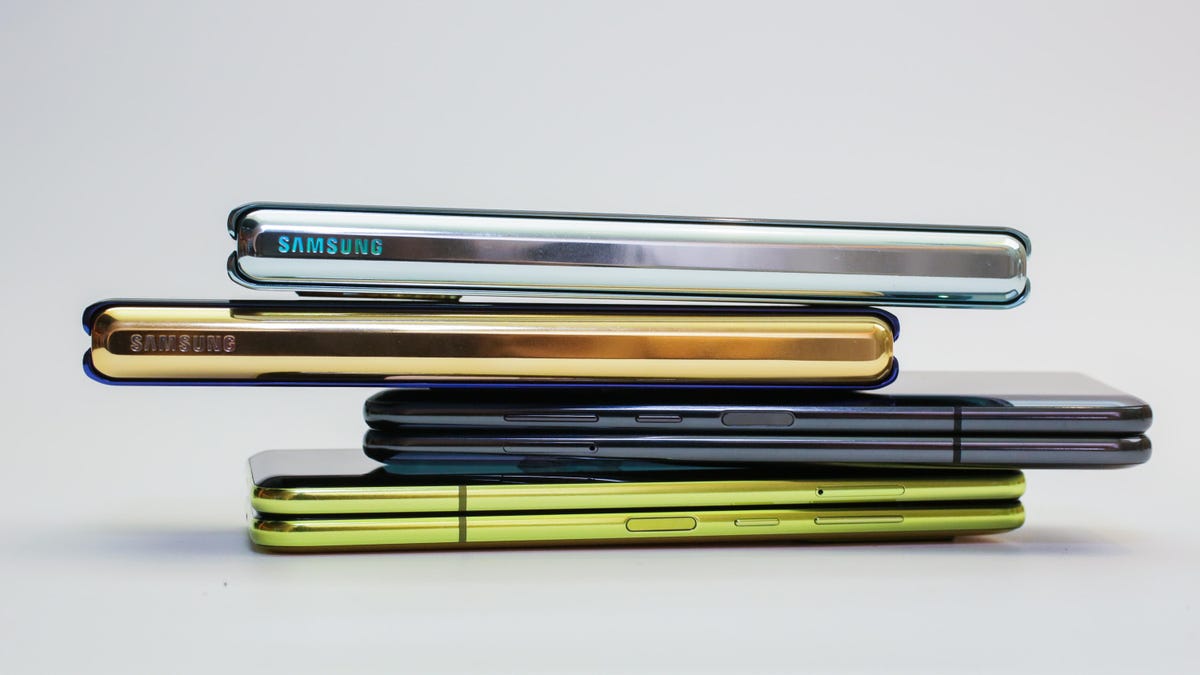

The original Galaxy Fold came in two colors that never made it to launch, and it let you customize the hinge color.
Sarah Tew/CNET
You can customize the Fold’s hinge color — again
You can buy the Z Fold 2 in mystic bronze and mystic black, and customize the hinge in metallic red, silver, gold or blue. Note that it could take up to five weeks for a custom phone to arrive.
This isn’t the first time Samsung has offered Fold hinge customization. The original Fold was sold in martian green and astro blue before the Fold screen disaster that saw production minimized and those flashy colors pulled. I originally customized my martian green purchase with a gold hinge. Hopefully this time around we’ll see those custom colors shine.
Galaxy Z Fold 2: What you don’t get
A foldable phone is a device of trade-offs. There’s no waterproofing, no 512GB storage option, no microSD storage card or in-screen fingerprint reader (it’s integrated into the power button).
Unlike last year’s Galaxy Fold, you won’t get wireless or wired earbuds in the box (you can specifically request wired USB-C AKG headphones from Samsung) and there’s no free case.
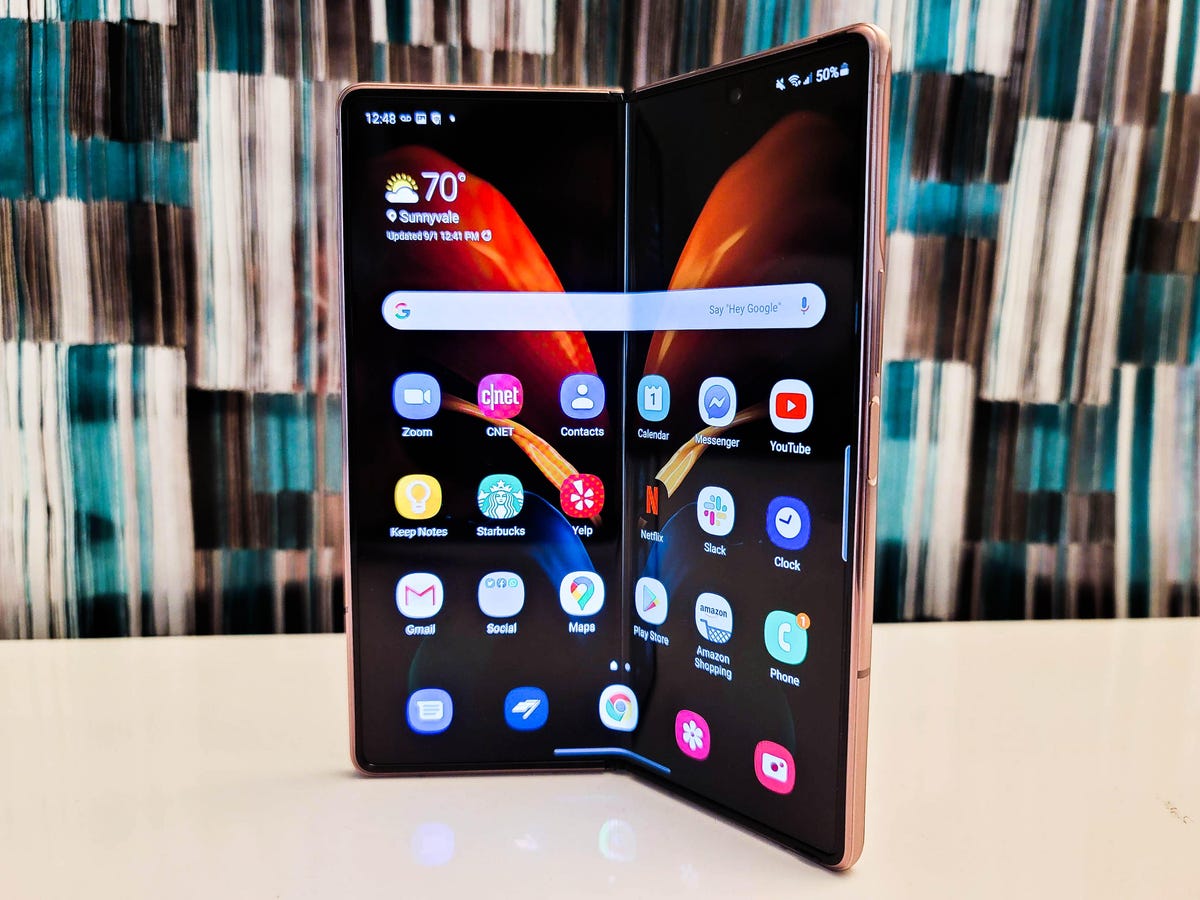

Samsung wants to make you feel like a VIP.
Jessica Dolcourt/CNET
Samsung’s VIP foldable Z Premiere treatment
Samsung has expanded its VIP club for foldable phones. Anyone who buys a Z Fold 2, Fold or Z Flip (including the new Z Flip 5G) gets access to the program.
- Galaxy Z Concierge program for on-demand customer service and consultation
- First-time screen replacement of $149
- Six months of LinkedIn Premium
- FoundersCard benefits: 12-month membership when you preorder. After launch, you get six months free
- A prepared meal from a Michelin starred restaurant through Tock
- Fairway Pass Elite through ClubCorp, which gives you access to golf clubs
- Six months of Obe Fitness online workouts
- $50 off Glamsquad in-home hair service
Galaxy Z Fold 2 vs. Galaxy Fold vs. Galaxy Z Flip
| Samsung Galaxy Z Fold 2 | Samsung Galaxy Fold | Samsung Galaxy Z Flip | |
|---|---|---|---|
| Display size, resolution | External 6.2-inch Dynamic AMOLED, 2,260×816 pixels; internal: 7.6-inch Dynamic AMOLED, 2,208×1768 pixels | Internal: 7.3-inch Dynamic AMOLED, 2,152×1,536-pixels (plastic); external: 4.6-inch Dynamic AMOLED 1,680×720 pixels (Gorilla Glass 6) | Internal: 6.7-inch Dynamic AMOLED; 2,636×1,080-pixels; external: 1.1-inch Super AMOLED, 300×112 pixels |
| Pixel density | 386ppi + 373ppi | 362ppi (internal screen) | 425ppi (internal); 303ppi (external) |
| Dimensions (Inches) | Folded: 2.67 x 6.26 x 0.6 in (hinge) ~0.54 in (sagging); unfolded: 5.04 x 6.26 x 0.27 in (frame) ~0.23 in (screen) | Folded: 6.3 x 2.5 x 0.6 in; unfolded: 6.3 x 4.6 x 0.3 in | Folded: 2.99 x 3.44 x 0.62 ~0.68 in; unfolded: 2.99 x 6.59 x 0.27 ~0.28 in |
| Dimensions (Millimeters) | Folded: 68.0 x 159.2 x 16.8mm (hinge) ~13.8mm (sagging); unfolded: 128.2 x 159.2 x 6.9mm (frame) ~ 6mm (screen) | Folded: 62.8 x 161 x 15.7mm ~17.1mm; unfolded: 117.9 x 161 x 6.9mm ~7.6mm | Folded: 73.6 x 87.4 x 15.4 ~17.3 mm; unfolded: 73.6 x 167.3 x 6.9 ~7.2 mm |
| Weight (Ounces, Grams) | 9.95 oz; 282 grams | 9.7 oz; 276g | 6.46 oz; 183g |
| Mobile software | Android 10 | Android 9.0 with Samsung One UI | Android 10 |
| Camera | 12-megapixel (main) + 12-megapixel (wide angle) + 12 megapixel (telephoto) | 12-megapixel (wide-angle), 16-megapixel (ultrawide-angle), 12-megapixel (telephoto) | 12-megapixel (wide-angle), 12-megapixel (ultrawide-angle) |
| Front-facing camera | 10-megapixel, 10-megapixel | Two 10-megapixel, 8-megapixel 3D depth | 10-megapixel |
| Video capture | 4K | 4K (HDR 10+) | 4K (HDR 10+) |
| Processor | Snapdragon 865 Plus | Qualcomm Snapdragon 855 | Qualcomm Snapdragon 855+ (64-bit octa-core) |
| Storage | 256GB | 512GB | 256GB |
| RAM | 12GBRAM | 12GB | 8GB |
| Expandable storage | No | No | None |
| Battery | 4,500 mAh | 4,380 mAh | 3,300 mAh |
| Fingerprint sensor | Side | Power button | Power button |
| Connector | USB-C | USB-C | USB-C |
| Headphone jack | No | No | No |
| Special features | Foldable display, 120Hz refresh rate, wireless charging support, | Foldable display, wireless charging, fast charging | Foldable display; wireless PowerShare; wireless charging; fast charging |
| Price off-contract (USD) | $2,000 | $1,980 | $1,380 |
| Price (GBP) | £1,799 | £2,000 | £1,300 |
| Price (AUD) | Converts to AU$3,270 | AU$2,950 | AU$2,999 |


Now playing:
Watch this:
Samsung and BTS introduce the new Galaxy Z Fold 2
9:28
The post Galaxy Z Fold 2: Impressive, but not perfect. Everything good and bad today first appeared on Joggingvideo.com.
]]>The post iOS 14’s major overhaul to the iPhone home screen might not be what you expect first appeared on Joggingvideo.com.
]]>This story is part of WWDC 2022, CNET’s complete coverage from and about Apple’s annual developers conference.
In some ways, Apple has given its iPhone home screen layout a major overhaul. But it may not be exactly the way you expect. It’s true that iOS 14 brings customization tools that present a new way to reorganize your apps for easy viewing and the ability to place widgets of multiple sizes all over the screen. You can even hide entire pages of your app icons that you don’t use but don’t feel like deleting. But what you’ll get is less redesign and more flexibility. How much or little you use the new tools is up to you.
In fact, CNET iPhone reviewer Patrick Holland described the iOS 14 home screen changes as “the same, but also different.”
That’s because when you first boot up your iPhone with iOS 14 (anyone can download the iOS 14 public beta now), you’ll see the same home screen layout you do now in iOS 13 or 13.5, with a grid of icons that stretches out over multiple screens.
See also
- Apple launches Arm-based Mac, iOS 14, MacOS Big Sur and more
- iOS 14 unveiled: A first glimpse at Apple’s upcoming iPhone software
- See all our WWDC 2020 coverage
In iOS 14, however, you’ll have several new options. You’ll be able to add widgets to the home screen if you’d like, including choosing their sizes and position and whether you want a new feature called Smart Stack to cycle a main widget depending on the time of day. (For example, you might want the weather in the morning and a wind-down routine at night.)
To view and hide multiple pages of apps you don’t often use or remember, press and hold until the apps jiggle. Tap the row of circles at the bottom of the screen. Select the pages you want to hide, then press Done.
Apple WWDC 2020 event
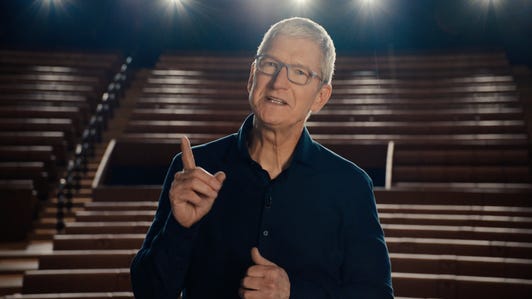



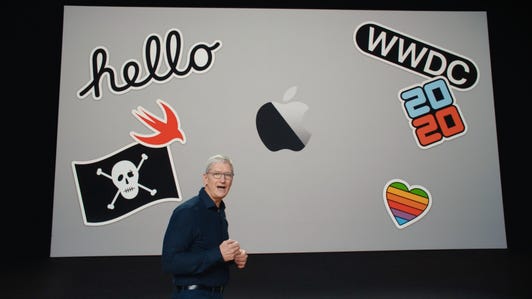

+57 more
The apps are still there, but now — and this is where that folder view comes in — there’s a new way to find them. App Library is Apple’s name for a new feature that keeps track of all your apps by organizing them into those big boxy folders you see above. You reach it by swiping to the right until you get to the end of your remaining home screens. Then swipe again until you reach the App Library — it’s like a bonus page.
And this is a page that’s curated through Apple’s AI. You have suggestions and most recently added apps at the top, as well as folders that have organized the apps you have by type — just tap to open. You can vertically scroll to find the icon, or you can type the app into the search field or scroll alphabetically by app name.
If you don’t want to use it, you can keep your screen layout exactly how it is and ignore App Library forever.
The same goes for widgets. iOS 14 will give you the same layout you have today by default, but you have the option to add widgets to the Home Screen yourself and rearrange them by dragging and dropping.
For some other cool new iPhone tricks you’ll be able to see on your screen, read up on the Picture in Picture video tool. And here’s every important detail in iOS 14.


Now playing:
Watch this:
Try a custom home screen using iOS 14
11:13
The post iOS 14’s major overhaul to the iPhone home screen might not be what you expect first appeared on Joggingvideo.com.
]]>